-
Posts
790 -
Joined
-
Last visited
Content Type
Profiles
Forums
Gallery
Events
Posts posted by JerryTodd
-
-
In late 1976 I got a job as a laborer on a construction site in Baltimore's Inner Harbor. At the site they were building a Baltimore Clipper schooner named Pride of Baltimore.
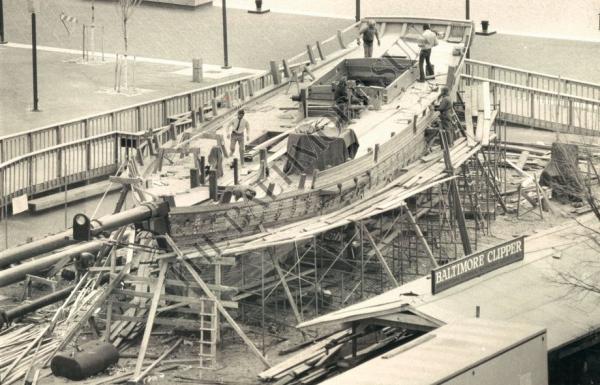 Pride under construction in November 1976, just about when I started there.
Pride under construction in November 1976, just about when I started there.
Five years later, on my 21st birthday, I reported on board as Pride's newest crew member. I spent two months aboard the boat in charge of her guns as she took part in the bicentennial reenactment of the battle of Yorktown.
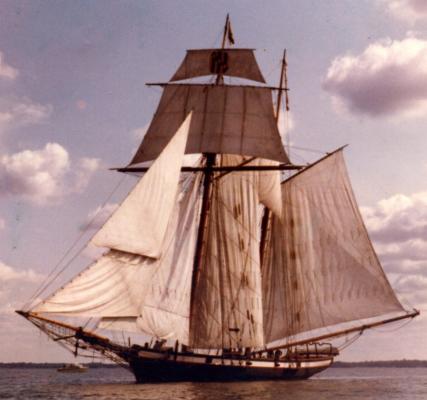
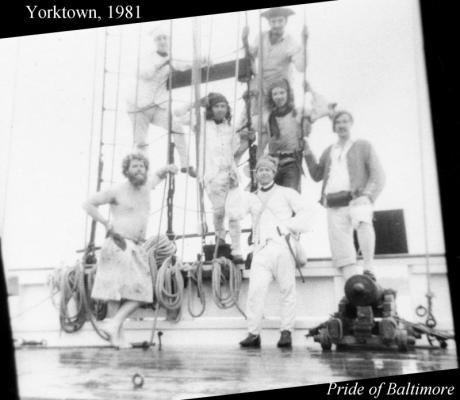 Yours truly is at the top right, in the cocked hat.
Yours truly is at the top right, in the cocked hat.
A summary history of the boat is available at my site, as is an album of the few photos taken during my time aboard.
In 1982 I acquired a copy of her plans from Thomas Gilmer with the intent to build a sailing model, but I was young, moved around a lot and it just never happened.
In November of 2011 I got to seriously thinking about actually building a model of Pride and figuring out what size to make her. The upper limit was as large, overall, as Constellation, but there was a lower limit also. I tried scaling her the same as Constellation (1:36), but looking at what she would need in terms of batteries, winches, servos, etc; I didn't see how I could fit the equipment needed to control so complicated a rig. I decided to make her 1:20 scale, as large as I could and still stuff her into a van or SUV.
With her lines scanned and scaled up I printed her stations on paper. There were glued to 3/8" CDX plywood, cut out, sanded, etc, and stood up on the old building board Constellation was built on.
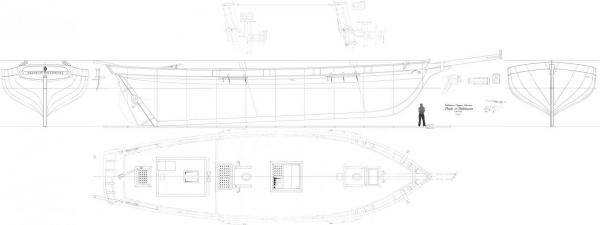 A work in progress: every item I draw in scale gets added to this plan.
A work in progress: every item I draw in scale gets added to this plan.
There they stood for nearly a year. On November 19, 2011 I cut out the keel, mounted it on the forms and began planking. I learned my lesson on Constellation and fully planked the hull, but I taped the edges of the forms so the planking wouldn't be glued to them, and they could be removed - leaving me with full access to the very limited space.
The hull was planked in pine strips 1/8 thick and 1/4" wide. They were glued to each other, but only pinned to the forms. The pins were akin to half-length straight pins and bent at the slightest look, making planking extremely tedious and hard on the fingers. I wasn't doing the next one that way. I also didn't spiel the planks, but just laid them on from the keel up, and the sheer down, leaving that football shaped hole to fill. The hull being glassed and painted, it wasn't an issue visually, except that it bother's me constantly. I'm not doing that again either.
By Halloween, the hull was planked.
The hull was filled, sanded, filled, and sanded some more. The aft-most form with the counter and transom forms was given a tap with the handle of a screw-driver and came right out. Soon the other forms followed, leaving the hull open.
The inside was sanded and then painted with diluted Tightbond III to get into the nooks and crannies of the planking and glue everything up. It was then given two coats of poly resin.
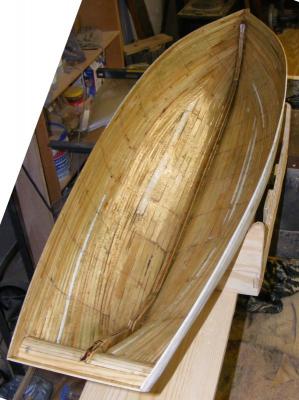 The stern post was too tall, a sign of advanced planning. I cut it down with a rotary tool - you'll see why later.
The stern post was too tall, a sign of advanced planning. I cut it down with a rotary tool - you'll see why later.
The stern and then the sides were fiberglassed with 4 oz cloth.
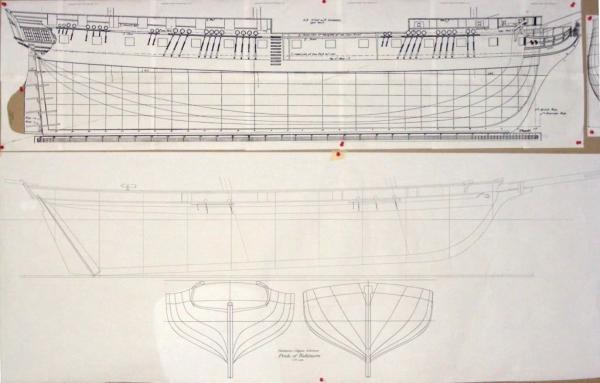 Pride's plan compared to Macedonian's
Pride's plan compared to Macedonian's
I restarted the build logs for Constellation and Macedonian that were lost in the crash. There never was a build log for this model on MSW, but, what the heck, there is now.
- Duanelaker, yvesvidal, Piet and 7 others
-
 10
10
-
Stern Windows
Further back, I posted a drawing of the ship in drydock in Boston Navy Yard (Charlestown) in 1859. Now I took another step toward that image.
I had cut out the stern ports back when I cut all the ports to install the resin gunport lids, but I didn't cut all the way through. I thought I would just install the window frames into this recess, but the fiberglass matt surface just wouldn't get smooth. So I cut out a port and made a window frame to install from inside the hull.
That looked like it would work, so I cut the rest of the ports, made more windows, epoxied everything in place, painted everything and Constellation no longer had a blank face, er, rear end.
The "glass" portions of the windows will get several coats of clear gloss. I didn't use glass because there's noting to see through them and I didn't see the point.
Medalions
Since she was built, to this day, Constellation has had three fiery star medallions on her stern; her constellation of stars; one in the center and one each on the backs of the quarter galleries. So far as I've been able to determine, these medallions are the original set she had when she was launched.
I tried carving one in Sculpty, but it was too bulky and thick. I had a little boxwood left over from a carronade I made for the Hornet project and remembering how nice it was to work with, I tried a different approach.
I sliced off a slab of the boxwood and cut and carved the star.
This was mounted on a sheet styrene backboard. Already it's looking better than the first attempt.
Bit by bit, I added details carved in styrene sheet.
When it was done, I primed it and then mashed it into some clay three times, poured a little resin in, and a few minutes later I had three pads of butter that looked like Constellation's medallions.
These were trimmed, sanded a little, washed, degreased, and primed. The raised details were painted gold...
The background was painted midnight blue. I examined the oldest photos where I could see these on Constellation and felt that there was a color difference there. Looking at common depictions of stars, comets, and shooting stars in period art and carvings, it seemed fairly typical to make celestial objects gold on dark blue backgrounds - so that's what I did.
The medallions were then given a couple of clear coats and then epoxied onto the stern.
As I mentioned on the chainplates, I decided to use wood screws to attach them to the hull, rather than through bolt them. To that end, I epoxied strips of oak inside the hull to give the screws something to screw into. I also put some fiberglass over the inside of the stern windows to make sure things were sealed up tight.
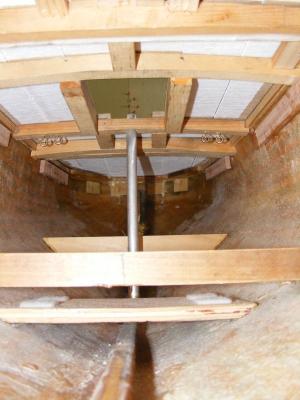 looking aft from inside the hull.
looking aft from inside the hull.As of this date, this is where the model stands on top of a cabinet in a living room, waiting for the shop to get put together so work can resume.
- hexnut, JerryGreening, fnkershner and 4 others
-
 7
7
-
A working model without a crew, to me, looks odd. I'm not modeling the Marie Celeste, but, in fact, a warship, which tend to have pretty large crews. Constellation had a complement of some 20 officers, 220 sailors, and 45 marines. I don't intend to include all of them, but there will be some 30-40 figures visible, especially around the pivot guns.
First, I have to determine what Officers, sailors and Marines looked like in 1856. The simplest are the Marines as I have reenacting buddies that do Marines of that period.
Officers I haven't nailed down yet, and sailors are a bit like these fellows, except I've seen these boys IDed as both US and British Man-o-War men. It's hard to find images of US sailors in the mid-1850's, except some Japanese art from Perry's visit.
I though the plethora of 1:35 scale military figures would make finding something I could convert easy - far from it. The closest I've managed are some WWII Russian sailors, but it was $5 for the set and I should be able to get a couple of basic figures to take a mold off of and clone a crew from them.
From this I assembled one fellow you've seen in several images above to help represent scale, I call him "Ivan." He was painted with acrylics per the method found on the web site.
-
Thank you for the kind words. When I started this project the Internet was pretty new, to me at least, and it wasn't easy finding information, or other people doing such things. Since then I've come across a bevy of wonderful models. Some aren't much up close, but beautiful under sail, while some just boggle the mind at any distance.
Victor, who built the Royal William mentioned earlier, built a Victory some years before, same 1;36 scale I think.
"Bill Huizing (pronounced Hy-zing) of Summit, New Jersey in 2009 completed an utterly magnificent RC model of the Charles W Morgan whaler seen by visitors to Mystic Seaport." quoted from Mark Steel's column in DuckWorks Bill doesn't do the Internet" built the 1:24 scale Charles W Morgan I think you'll appreciate. There was a YouTube video of it sailing, but it's become "private" sorry folks, it was something to watch it sailing about in Mystic Harbor, a harbor I've sailed about in myself a few times.
This little fella from Down-unda built himself the bark Sindia - now that's impressive - he can nearly get in it and sail it himself!

The sailing and static pictures are all very nice, but I tend to go looking for the shots that show the guts, how they handled control, and how they transport these beauties! Guess I'm just an RC square-rigger geek.
- fnkershner, druxey, mtaylor and 5 others
-
 8
8
-
Now we come to the chainplates. I was initially going to bolt them through the hull, and that requiring access inside the hull, would delay getting the deck on, which, in turn, delays getting on the deck details and hammock rails, etc, ie: finishing the darn thing. Instead of bolting them, I will use brass wood screws into an oak backer inside to attach them to the hull. I feel this will have the required strength and allow them to be removed, if need be, for repair or replacement. Riveting them, as the originals are, would be too much trouble to deal with at this scale.
Constellation's chain-plates consist of five basic parts
- A strop that wraps around the lower dead-eye and bolts to...
- a link strap that lays against the channel and is connected to...
- an oblong iron link that is connected to...
- another link that's shaped like a bent exclamation mark (I call it the "pinched-link,") and pinned to the hull by a...
- dog-bone shaped, half-round, iron backing-link that is riveted to the hull and spreads the load.
The ship appears to have retained her chain-plates through the years. What's on the ship today appears to be the same as the earliest photos where they can be discerned. I'm reasonably certain what's visible in the 1914 photo is correct for 1856 - and unable to find evidence to the contrary - that's what I'm going with.
I'm making the chainplates from brass sheet and rod in the same layout as the originals. This way they should function well enough for the model while looking correct, and to scale.
It's times like this I wish I could manage some photo-etching so I could make a whole pile of the link-strap (#2) at once - they really are quite a pain to make. The pinchlink isn't too bad; I wrap it between two pins in a block and literally pinch it. Soldering I do with soldering paste and a micro torch.
They will be painted, but I blacken them to give them a sort of primer coat first.
I haven't had much luck making the strop. The real ones are doubled iron rod, but brass rod small enough to double doesn't like being soldiered. I plan to try it with a soldering iron and see if that works better than the torch.
The backing link is a half round piece of iron with the flat against the hull. I haven't figured out my approach to this part yet, though it would be nice to PE a whole set of them and be done with it.
So far I have 46 each of parts 2, 3, and 4 shaped and waiting to be soldiered.
- hexnut, JerryGreening and mtaylor
-
 3
3
-
Constellation was originally fitted with two 10" shell guns mounted on the spar deck and designed to pivot. They can be seen in deSimone's 1856 portrait of her at Naples.
Her bulwarks where the guns were mounted, were made into panels that could hinge down, out of the way as seen in the sketch of her stern in 1859, and a photo of the bow portion which she retained right up into the mid 1950's, when she was brought to Baltimore. The stern portion were reduced so only the panels at the quarters remained, and then at some point they were removed entirely and a "solid" bulwark installed.
Some of the bronze hinges for these panels still exist, though the ones for the stern are long gone and many for the bow are missing.
The guns themselves were mounted on carriages that slid on a chassis that could be pivoted on either end, or in the center. Iron tracks were screwed on the deck to keep the chassis from tearing it up. What pattern these tracks were laid in I've yet to discover. The restoration folks say that somewhere they're referred to as "circles," but I've read accounts from the Kearsarge that refer to them as "circles" or "traverse circles " where photos of her deck show something more complex than a simple circle, but more akin to what's seen on this model of the sloop of war Savannah, razeed from a frigate.
In fact, manuals printed prior to the Civil War are, I believe, much closer to what Constellation probably had:
I actually started making these guns before work resumed on the model in 2009. I didn't have a lathe yet, and tried turning a barrel on my drill press, which didn't turn out well.
My friend Dan, following my build on RCGroups, offered to turn a barrel for me and sent me a lovely piece of work. I fined it up and added some details to it, then made a rubber mold and a resin casting.
The mold got bubbles in it and the casting came out looking like the gun was recovered from the bottom of the ocean. I'll have to come back to that experiment at some point.
The chassis for my carriage was a modified version of the plan I acquired from the Archives for the steamer Mississippi's guns. At the time I was under the assumption that rollers were required at either end to function on a single circular track. The manuals, showing the exact same chassis, show that is not the case - so these will be rebuilt, or replaced, with correct ones at some point.
These guns were replaced with a pair of Parrot Rifles at the start of the Civil War; a 30 pounder forward, and a 20 pounder aft, both on mounts very similar to those of the 10" shell guns. Plans for these mounts are also available at the National Archives, and are what the restoration people are hoping to install someday. They already have a 20 pounder Parrot tube on board mounted on an ordinary truck carriage.
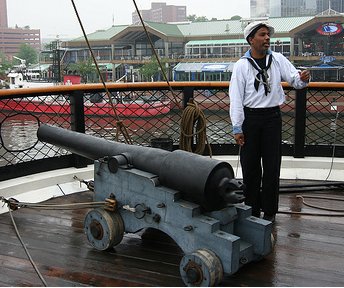 Note the size of the 20 Parrot compared to the model shell gun as compared to the men.
Note the size of the 20 Parrot compared to the model shell gun as compared to the men. -
I like the poats too
 They're a fun side project and I'm looking forward to completing these and getting the rest built. I've got as many to build for Macedonian; a Zodiac and a boat for Pride of Baltimore; and Gazela Primeiro will have a few dory's stacked on deck - it's almost a hobby unto itself.
They're a fun side project and I'm looking forward to completing these and getting the rest built. I've got as many to build for Macedonian; a Zodiac and a boat for Pride of Baltimore; and Gazela Primeiro will have a few dory's stacked on deck - it's almost a hobby unto itself. -
A few more gunports were cut out, some stern windows, and holes drilled in the rest of the ports (I cut them starting with a drilled hole). I'm real careful cutting out these gunports as what's left will be the finished product and I don't want to screw it up - that's why it's been a bit slow - I only do maybe 4 at a time.
My situation hasn't changed, I'm still trying to stuff 20 pounds into two 5 pound bags, but I have made some progress. Then a pipe broke in the house I'm moving out of and it rained into my basement, which was my "office" and living room. I had already moved a lot out, like my wargames and books, but some things got damaged, and few things destroyed.
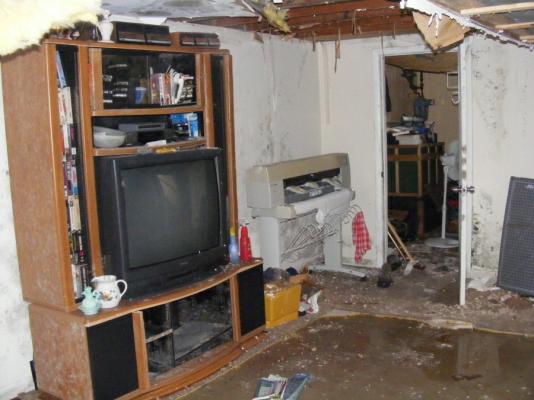 and this is after some clean-up took place.
and this is after some clean-up took place.The models had been moved some time before, along with supplies, tools, etc. Some of my plans got wet, but I managed to save them. A couple I had printed on the plotter were lost, but I can reprint those.
My shop, which is officially known as
 has been moved to a 13 x 20 garage and needs to be organized and set up, which will mostly involve running adequet electricity. There's 88 square feet less floor space in the new place, but it's got a good concrete floor and all my tools and benches are, or will be on wheels. The first project will be a proper dust collection system since the place is attached to the house, my lady would appreciate it if I didn't track sawdust everywhere. It'll be nice this winter when I won't have to trudge 20 feet through the snow to go the the loo, just go in the door and there it is.
has been moved to a 13 x 20 garage and needs to be organized and set up, which will mostly involve running adequet electricity. There's 88 square feet less floor space in the new place, but it's got a good concrete floor and all my tools and benches are, or will be on wheels. The first project will be a proper dust collection system since the place is attached to the house, my lady would appreciate it if I didn't track sawdust everywhere. It'll be nice this winter when I won't have to trudge 20 feet through the snow to go the the loo, just go in the door and there it is. 
So, this brings the log up to current, as of the first week of September 2013. When work resumes, Macedonian will get her remaining gunports cut out, and then internal framing around each will be installed. Moldings will be applied to the hull and the quarter deck and focs'l ports will be cut out. Then, I think, she'll be ready for some paint.
In the mean time, I'll edit some of the posts above to fix omissions, and my fat-fingering of the keyboard, to try to get it as complete as possible. I would appreciate any questions or advice any one might have about my approach to a large scale remote-controlled square-rigger, up to this point, at least. There's a lot of challenges ahead on this thing and controlling the squares is actually the least of them. The fore-n-aft sails that over-lap and cross over stays are more of a challenge. The figurehead and other ornamental items will, for me, be as much of a challenge. I'm completely broke, so getting fancy tools, photo-etching, 3d printing, and quality woods like boxwood, is pretty much out of the question, so I have to make do with what I have at hand and the skills I can muster.
- Bluto 1790, mtaylor, archjofo and 3 others
-
 6
6
-
Ship's Boats
In September (2010) I got a copy of the lines for Constellation's boats from the National Archives in Silver Spring, Maryland. I cannot convey the feeling you get holding an original document dated 1854 in your hand. To look at the erasure marks, and handwriting, and all the details put on this paper 156 years before. The archives actually scanned them for me and I also got a paper copy. They're drawn in 1:12 scale (1"=1') and only show the lines, no construction details, hardware, seat arrangements, etc; but they are, specifically, Constellation's boats.
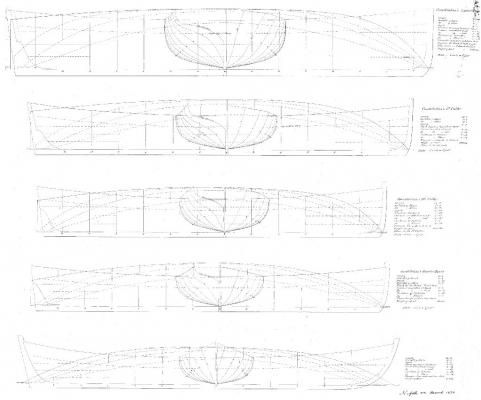
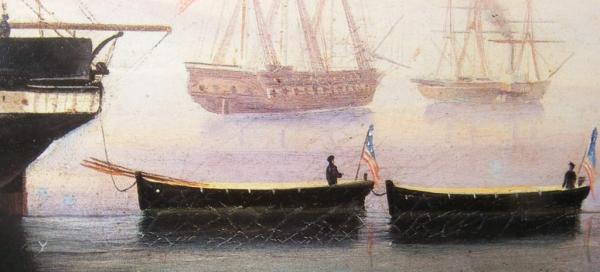 <= Constellation's boats in 1856 by deSimone.
<= Constellation's boats in 1856 by deSimone.Again, I sifted through MSW to see how other built their boats, and found a variation on a common theme in Gene Bodnar's thread on building a 1:32 scale Constitution in six sections. His boat's were about the same size, maybe a little bigger, as mine would be.
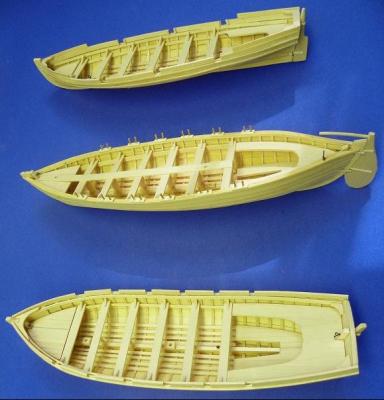 <= Three of Gene's boats for Constitution.
<= Three of Gene's boats for Constitution.This method of building ships boats is basically the same way I build any model hull...
There's 6 boats in all: a 31' launch, a 1st cutter of 28'7", a 2nd cutter of 25'10", two 26'6" quarter boats, and a 28'2" whaleboat, which I assume hung on the stern as there's no "stern boat" listed. All but the launch I believe to be clinker built.
I decided to start with the 1st Cutter. It was the largest clinker built boat of the group. I produced patterns for all the boats and printed them on 8.5" x 11" label paper. Then I cut them out, peel them off, and stick them on the wood. The parts for the stern-post, keel, and stem was basswood (lime), but the forms were balsa. I used balsa because of the small size, ease of shaping, and I had several sheets of 1/8" sheet laying about. Also, when it came time to separate the model from the forms, balsa would offer the least resistance, and would give before a rib did if something stuck that shouldn't have.
The forms were cut, trimmed, sanded, beveled, and glued to a building board.
Each form got a rib bent over it made of 1/16" bass. These were held by rubber bands to the form. The transom, stern-post, keel, and stem were shaped, rabbeted, and bearded as required, glued together, then glued in place on the ribs.
Planking of 1/32" bass sheet, commenced at the garboards, and proceeded up to the rails. Being clinker built, there's no other way to to do this but to spiel each plank and put them on in order.
When the planking was complete, the stem and transom were cut loose of the build board and the boat was lifted off it's forms.
The forms are actually at every other rib, so additional ribs were bent into the hull. Rub rails were glued on. Floor boards, oar notches cut, and seat clamps installed.
Seats fitted. The model was painted, and more details added; meanwhile the largest of Constellation's boat took shape.
The launch was carvel planked using the same set up used for the cutter; but the building board was made narrower so the form would over hang the sides. This allowed me to use rubber bands and clothespins as clamps where the build board was in the way before and prevented that on the cutter.
The launch is a 30' boat with a coppered bottom and mounting a boat howitzer, with a whole structure for handling the gun inside. I "coppered" the bottom with peel and stick aluminum duct tape, which is sheet aluminum. I painted that copper with the paint I had painted Constellation's bottom with.
The launch is ready for it's gun, but still needs some details, like the iron fittings the gun carriage attaches to, and the gun and both it's carriages. Both boats need things like seat knees, oars, rigs, etc - before they can be called complete.
Next: Pivot Guns
- mtaylor, hexnut, JerryGreening and 2 others
-
 5
5
-
Fiberglass
With frames set in and the hull's shape stable, it was time to glass the outside.
I started with the transom
Then the portside
Once that had set-up, it was on to the starboard side
There, that wasn't so bad
Excess resin went into the bilges and on the lower frames.
After the glass set-up and was sanded, there were some blisters where the glass didn't lay and bond to the hull, these came off while sanding and were filled with auto-body putty. More sanding and another coat of resin brushed on, then sanding again. Some clean up and degreasing and it's...
Wale Ho!
On this model the wale isn't the structural member it is on a real ship, but I did want it done in an anchor-stock pattern as it would be visible on close inspection.
I started by cutting a block of white pine, as used for the rest of the planking, to the offset anchor-stock shape, then slicing off 1/8" thick planks.
I started on the starboard side by marking the positions of each plank on the hull from the bow aft, and actually started gluing them on amidships. I used CA to attach them to the hull, and Titebond III to glue them to each other.
Clamping them to the hull took some thinking at places, as did clamping them to each other without lifting them off the hull.
At the bow the pieces needed to be precurved, so the SBJ (Sophisticated Bending Jig) was employed. The pieces were wet, clamped in the jig, and left overnight.
It took a little over a week, but the starboard wale was done. Now to the port side!
I took a slightly different approach this time. Clamping the pieces to the hull was quite tedious, so I used the nails I used to hold the planking with during construction to hold the pieces onto the hull here. This made things go much quicker and smoother.
Before starting though, I cut out a gunport just for fun. I was afraid the hull would flex with the ports cut out, but I need them cut before I frame up the hull thickness behind them, because that framing sets into the gunport opening a bit. Actually, the planking is set back creating a rabbet for the lid to close against.
My friend Mark was building a crabbing skiff at my place, and while he had the epoxy out, I stole a bit to give the wales a couple of coats
I then started carefully cutting out each gunport opening. Once all the gun ports are cut out along the gun deck, the internal framing will go in around each one, making the hull the right thickness as seen through the gunports. The focs'le and quarterdeck ports will be cut after they're framed and the external moldings have been installed.
- SailorGreg, druxey, fnkershner and 14 others
-
 17
17
-
Lines were rigged connected course yard to course yard the same distance from the center-line on each side of the model. Lines that would serve as braces ran from the main course yard ends to the quarters of the hull and to the springs on the post, and then to the winch. This way the winch would swing the main course yard and the connecting lines would move the fore and mizzen yards at the same time. This is not how the model will eventually be rigged for running, but it would do for a test sail.
The fids were pulled, the topmasts lowered, and batteries put on the chargers.
The next day, July 10th, 2011, the model and it's equipment and accessories, were stuffed into the Tahoe.
I took the model, and my lady who was to be the official videographer, supplied with camera and tripod, a quarter mile down the road to Sloop's Cove on Stoney Creek, where the neighborhood has a public pier and water access - such as it is.
At the site I raised the rig, bolted on the ballast, and tested the systems.
Getting her into the water, I placed the sandwich bags full of lead bird shot left over from the ballast torpedo and weighing about 12 pounds, into the hull and moved them about to trim her. There still wasn't enough weight to get her down the the LWL and she stood about 1-1/2 inches high in the water.
Then off she sailed.
And some of the video...
It wasn't an unsuccessful day, but it was a bit disappointing. The winds were too light and variable, and in the creek there, they swirled and eddied about. The model never really got more than a few feet of any real sailing. When it would puff strong for a bit, she handled it fine, then it would shift and catch her aback. She also handled the occasional wakes from passing boats quite well. Then, about an hour in, the battery died. I later found it had failed completely and needed to be replaced. The model was near the middle of the 100 yard wide creek and headed toward a boat dock about 50 feet away from me. I went into the water and swam over to meet her. She gently bumped her forestay against the dock and stayed there till I got to her. I'm not much of a swimmer and quickly wished I had brought one of my floatation vests to make the job easier - but it was in the 90's and the water felt pretty good. Next time I'll have some form of chase boat; a kayak, inflatable, or preferably a pram I'll build.
Note: That thing at the base of the mizzen is an on-board camera. It took some incredibly boring video. If I can get some editing software that will let me put it up split-screen fashion in sync with the other video, I'll post it somewhere.
Video of the Recovery or how the big bald ape rescued the model ship from certain doom without himself drowning.
Then it was out of the water, off with the ballast, down with the rig, and into the truck.
- mtaylor, SailorGreg, JerryGreening and 5 others
-
 8
8
-
A brace was installed under the quarterdeck level to hold the curve in the transom.
On Christmas day I found that St Nick hadn't sanded and resined the interior of the hull as I had hoped, so it fell to me to do it. It was sanded, cleaned, and given a couple of coats of poly resin. Excess resin was poured into the bilges to fill any nooks and crannies so small parts, dirt, and water would have no where to hide.
A full size paper pattern of the gun ports, moldings, and other such hull details was made. Care was taken to use the plan to make sure items that were on surfaces curved away on the profile were in their proper place, such as the bridle ports. As I was cutting out the gunports on the pattern I realized I had formed a gunport lid; I couldn't resist doing them all that way.

Macedonian is a little shorter than Constellation. Constellation compares in length to the frigate United States so you get a little bit of an idea of the size relation between Macedonian and United States.
The build table was leveled, then the hull placed on it level port and starboard, and with the waterline marks fore-n-aft at the same height from the table. A pencil resting on a block of wood cut to the right length was used to mark the waterline.
Approximately every-other station used to make the hull was cut down to scale framing dimensions and reinstalled into the hull. The reason for this is because the complex shape of the hull with it's tumble-home and counter tumble-home, was trying to flatten out. These frames are glued into the hull with epoxy mixed with wood dust.. The rest of the interior from the gun deck up, will get framing and ceiling planking to make the hull the proper thickness.
Some idea of the size of the thing - 5 foot from tip-to-tip.
Next: Fiberglass!
- The Sailor, Tadeusz43, mtaylor and 13 others
-
 16
16
-
The 1854 sailplan shows 17 sails. There were stuns'ls, though they're not shown.
The sails will be made from DuPont Supplex. Supplex is the sail cloth provided with the SC&H kits. It's strong, light, UV resistant, wrinkle resistant, and water resistant. It's typically used in wind-breakers and such garments. Besides, the appearance and performance experienced by my friends Dan Lewandowski and Victor Yancovitch on their models is a pretty good selling point
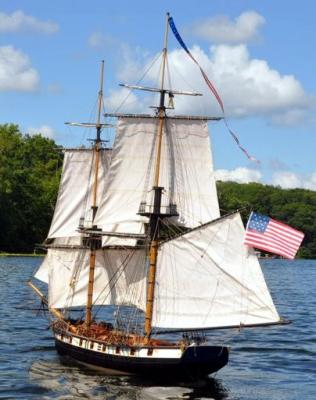
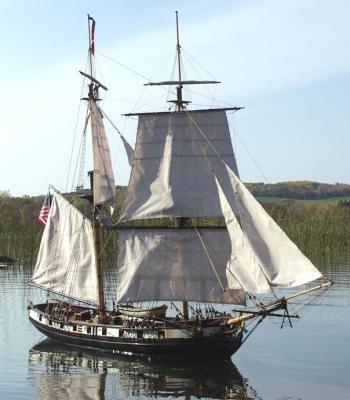 Dan's 1:24 Syren (from an SC&H Grasshopper kit)
Dan's 1:24 Syren (from an SC&H Grasshopper kit)*** I get Supplex from Rockywoods.com. I got white, but some might prefer the color they list as "Nomad." I think that used to be listed as "Wheat"and is the color used by Victor on his Royal William.
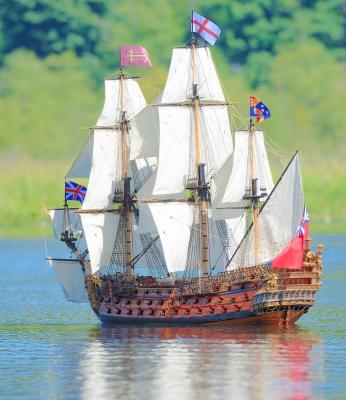
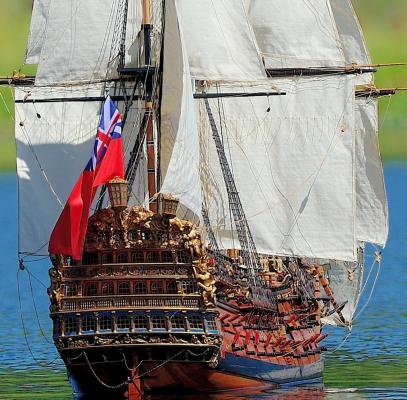 Vic's scratchbuilt 1:36 Royal William
Vic's scratchbuilt 1:36 Royal WilliamConstellation will inevitably carry some 2,807.01 square inches (1.8 square meters) of sail, but for now I'm focusing on 5 sails; the jib, driver, and three tops'ls. (#'s 2, 6, 11, 15, & 14).
One change I made to the sail plan was raising the clews of the heads'l a little to make it easier to pull them across the stays. Interestingly, this was done to the actual ship's heads'ls at some point as can be seen in the 1862 portrait of the ship.
Each sail was drawn on paper full size, and cut from the cloth with a hem allowance added. All sail panels were drawn on with a .05 fine point permanent marker. Tablings were cut from the cloth and the edges heat sealed with a hot knife. These items were glued to the sail with Liquid Stitch fabric adhesive and ironed with a clothes iron.
Holes were made for lacings, reef points, etc with the point of a hot soldiering iron, which makes a hole and seals it against runs at the same time.
The hem was folded and glued, then folded and glued again and all ironed flat.
Then came the bolt rope. This is nylon cord about 1/16" diameter. It's glued with fabric glue and stitched onto the sail as was done on the prototype, except I did a stitch about every three strands instead of every strand.
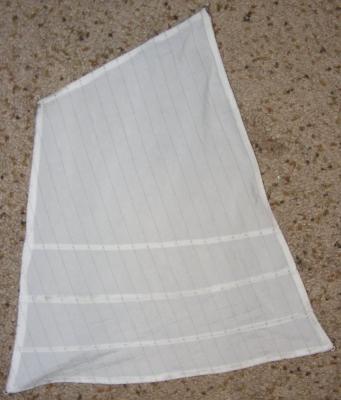 Driver
Driver 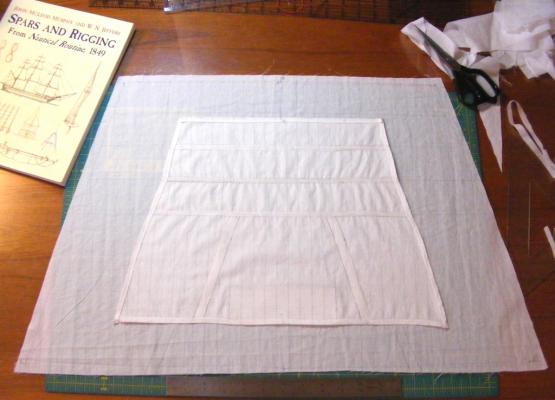 Mizzen tops'l (on just cut main tops'l)
Mizzen tops'l (on just cut main tops'l)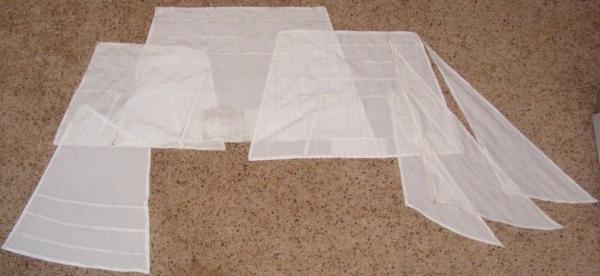 All the sails were cut, all the heads'l were hemmed, but only the 5 needed were bolt-roped.
All the sails were cut, all the heads'l were hemmed, but only the 5 needed were bolt-roped.- EdT, aykutansin, hexnut and 2 others
-
 5
5
-
The hull currently currently weighs 9 pounds, and you'll see some more is going on, and some is coming off.
-
Some blocking was added forward to reenforce and brace the stem
The counters were planked and as the side planking proceeded, the counters were trimmed.
Planking continued until it reached the counters and could be attached then the transom was planked. Blocking was added to the bottom of the counter to catch the plank ends.
At the bow, blocking was added to give more surface for attaching the plank ends here.
Planking continued around the turn of the bilge. Now the planks had to make a hard bend up to tuck onto the counter. To prebend tthe planks I wet them and clamped them into a jig.
A brace was added to support the top of the transom and prevent it's loosing it's curve.
A set of wide garboard planks was also installed to rigidify everything a bit.
As the planking continued on up to the sternpost, and with the garboards in place, the keel and sternpost were fitted.
A template for the forefoot and stem were made and the forefoot fitted.
The hull was rigid enough to remove from the build board, see it right-side up, and look inside.
A stem and gammon knee were cut out and fitted
and before long it was time to put in the shutter plank.
The hull was completely planked. It took from November 12th, to December 19th to plank the five foot hull, 37 days.
A couple of days later the stem head and stern post were permanently attached with 6p finish nails reenforcing all of it to the hull. Some of the forms were removed as well; they require a light tap with a block of wood to be knocked loose. Some of them would be cut down and reinstalled as permanent frames. A stand was built to hold the model as she's being worked on.
The entire surface of the hull was filled with Water Putty and sanding commenced.
- Bluto 1790, archjofo, druxey and 10 others
-
 13
13
-
Moving up the masts, I started on the topmast cross-trees and trestle-trees, and the topmast caps.
Another item I came across here at MSW was the idea of laminating some items, among them, cross-trees. These are made of bass (lime wood) and laminated in a form just the way I saw it done here. The ends are seized with poly thread and set with CA glue to prevent the t'gallant shrouds from splitting them.
The caps were cut from 1/8" aircraft plywood and everything got painted white.
Eyes were set into the stem for the bobstays. They're a little over-sized, but I felt there was going to be a lot of strain here and wanted the extra strength a larger diameter rod would give. These eyes are 1/16" brass rod made into eye-spikes and CAed into the stem at 90° to the bobstays. They're connected and reinforced with a brass plate that is glued and nailed to the stem and soldered to each eye.
Then it was outside for a photo.
Here it was the middle of April, 2010. I wanted to get the hull in the water again, but I didn't just want a float test, I wanted a sail - so I made a goal to jury rig her enough to sail by July. The first weekend available in July was that of the 10th, so that became my goal.
There were several items that would have to be done to be able to sail the model, even jury-rigged:
- Shape the still rough cut yards; fore course, fore tops'l, crossjack, and mizzen tops'l yards.
- Complete the yard trusses with mast bands and banding to attach them to the yards
- A gammon "iron" for the bowsprit.
- Rudder control & steering.
- New winch drum for braces.
- Sails for planned sailing suit; 3 tops'ls, Spanker, and jib.
A gammon "iron" was made of copper - the same sheet the rudder gudgeon plate and tiller were made from. The actual ship had an iron gammon fitting instead of the traditional rope wrapping. Two copper nuts are soldered to the bottom allowing two copper machine screws hold the two halves of the "iron" together, clamping the bowsprit between them.
Another "iron" fitting goes on each cap for the yard's lift tackles to attach to. These, again, were copper and glued and nailed to the cap.
The required yards were shaped
The original drums for the winch servos were made of wood disks sandwiched between plastic compact-discs. These warped so I made a new one substituting 1/8" thick sheet styrene for the wood disks.
The steering set-up for the rudder mentioned earlier was put back in place.
The trusses were attached to the course yards with brass banding held by nuts and bolts. Threaded eyes were attached and copper banding made for the masts.
All that was left was to make
The Sails
- hexnut, JerryGreening and mtaylor
-
 3
3
-
Channels, Quarter Galleries, and Paint
The channels were made from pine and their shape, position, and size were taken from the 1888 spar deck plan, as will be many other deck details. The Archives listed an 1854 spar deck plan, but it was, and still is, missing from their files.
It was time now to repaint. Painting up to this point has only been a quick job of spray painting, now I was going to finish the gun stripes properly, and get into some nooks and crannies.
I don't know what these things are called, the only name I've seen is "drops," so, I made them of sheet balsa laminated into blocks which also meant the quarter galleries were finally and permanently affixed to the hull with epoxy and the screw that had held them since their beginnings. The insides of the quarter galleries had been thickly painted in resin some time ago, in case any moisture managed to get inside.
The gun stripe now went through the head as it should, and the masts and tops also got some fresh paint.
Course Yard Trusses
Constellation's course yards are attached to the lower mast via a set of iron trusses. These are really quite impressive items that will be as important in the operation of the model as they undoubtedly were on the ship itself. Unlike the trusses on the clipper ships and most modern square-riggers; Constellation's pivot out further from the mast where the more common type pivot at the mast and hold the yard off on a post. This allows the yard to be braced further over and allow the ship to sail closer on the wind. Constellation's truss design also allows the top masts to lower through them without having to disturb the yard in any fashion - something that will help me lower the rig on the model for transporting.
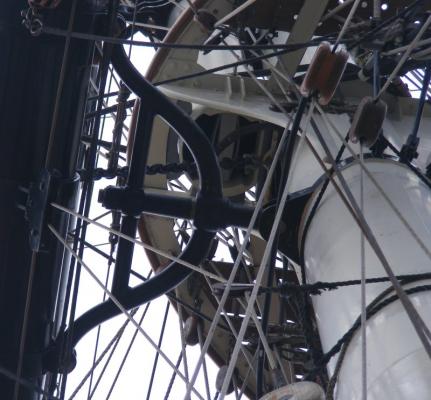 <= Stad Amsterdam
<= Stad Amsterdam 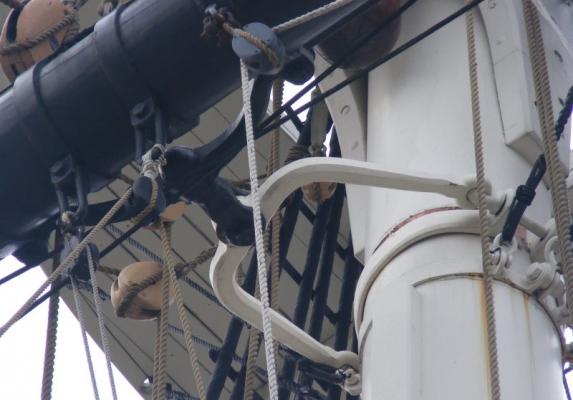 <= Constellation
<= ConstellationIt's very fortunate to have the actual ship available to reference, and that so many of her original fittings survived the attempt to make her into a frigate - these trusses for instance. Using a photo of a truss on the ground and my own photos taken from on deck, and using the diameter of the masts for proportion, I designed a set for the model.
I ordered a sheet of 1/8" thick aluminum online and began cutting out my parts on a band-saw with the narrowest blade I could get. I'm not really set-up for working with metals, but I trudged along.
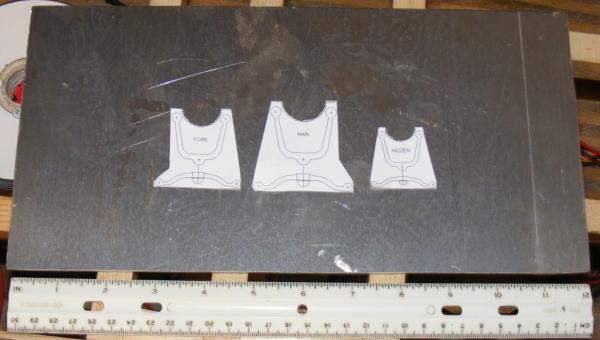
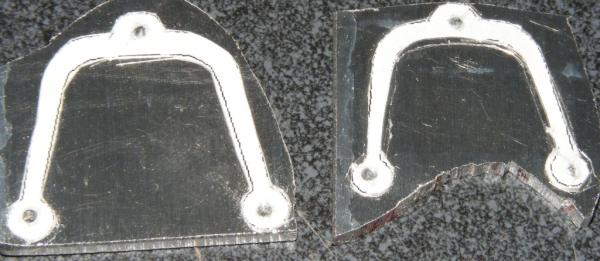
Cutting out the parts was tough enough, making the bows made that seem easy. The bow's center bulge was vertical and swelled to as much as a 1/4" while the ends were horizontal. I opted to get this shape by heating and twisting the ends. First I drilled them, then I heated them, then carefully twisted the ends 90°. Most of them worked out very well, but a couple broke and had to be remade. With some filing you can see they're twisted at all.
The remaining part to make were the clevis'. This was made from some aluminum rod, drilled, slotted, tapped, and shaped with files to match the iron clevis' of the real thing.
Here's a shot taken a bit later showing the top mast lowered through the truss:
-
I was rereading Hornblower while waiting to be called for jury duty when someone noticed and asked if I was familiar with O'Brien's series. I wasn't, but during our lunch break I walked over to the bookstore (I was in Annapolis) and found the first book.
I had read a biography about Cochrane a few years before and I was actually very disappointed by what was basically a blatant theft of Cochrane's early career for some novel. Further, the first book is the longest of the series - it's certainly the slowest. It very nearly ran me off, but O'Brian was very good at immersing you in the period, so I struggled through, though most of the time it was an exercise at staying awake.
I felt that I had to do a lot of work to care about these characters, O'Brian only gives you this external view and Aubrey is more of a caricature. It's an early 19th century maritime odd-couple.
I haven't read all the Hornblower knock-offs out there. I read several Bolitho books and hated them. I'm told most other series are better, but I find that modern writers can't write, and nothing I've read yet gets across the feeling of the period like O'Brian and Forester, who were both from a pre-computer time. What I've read so far seems to have been written in a hurry with a pay check always in mind - like television.
Forester's The Captain from Connecticut got me into this back when I was around 10, and I've reread the Hornblower series several times, nothing yet compares. The Good Shepard, The African Queen, the Gun, all are great stories well told. O'Brien was good, Forester was great.
-
The building board that Constellation had been attached to since 1999 and the Pride of Baltimore was built on, was showing it's age. It had it chips and dings repaired, holes filled, was sanded, and given a couple of coats of flat white paint. It was then marked with a center-line and lines for each of Macedonian's stations.
Each plywood form was attached to a strip of wood to allow it to be stood up and attached to the build board at it's station line.
It wasn't really clear to me how the stern came together based on the drawing, but studying several of the fully framed models here on MSW helped me figure it out, and how to deal with it in my particular, and peculiar construction method. Forms were devised for the construction of the stern and the aft perpendicular form was discarded.
A keelson was cut from 1/4" plywood and corresponding notches were cut in each form to receive it. It isn't glued or fastened to any of the forms as it will become part of the model where the forms will be removed.
The edge of the forms are taped to prevent the planking from being glued to them, and a batten was nailed to the lower diagonal to steady everything. Planking then began with 1/8" x 3/8" pine strips starting at the sheer strake. I used 3/8" common nails to hold things in place. I used smaller nails on Pride of Baltimore that were almost like straight-pins, but these bent so easily they became quite frustrating. The next strake was glued to the sheer strake, and pinned and clamped in place. This, basically, is how all the planking was installed; each strake glued to it's predecessor and finally to the keelson, stem, sternpost, and counter forming a wooden shell of a hull.
- mtaylor, qwerty2008, archjofo and 7 others
-
 10
10
-
The lady I'm with comes from the land-locked country of Oklahoma, and doesn't really get things maritime. I did have to take up square-dancing though, but then those are the sacrifices we make for our hobby.
I wanted to do the Baltimore Clipper in 1:36, but there just wasn't enough room in the hull for the controls, or much else, so I went with 1:20 scale, which makes the overall model about the same size as Constellation and Macedonian. This is about as large a model as will fit in a van or SUV with the rig lowered, though I hope to eventually make a trailer for them so I can keep them fully rigged in transport.
- CaptainSteve, qwerty2008, Jaxboat and 1 other
-
 4
4
-
I first set foot on board the Constitution when I was 7 years old, and I was hooked on sailing ships ever since. My elementary school library had C S Forester's The Captain From Connecticut which I loved and led me to Forester's other work, namely Hornblower. In fact, the 16 foot daysailer I've had since 1979 is named Lydia. I spent my teens and twenties working under sail and power, from barkentines to tugs.
I've built several of the 1:96 scale Constitution/United States Revell kits, two of them were RCed; but I always wanted a sailing model of the ubiquitous British frigate, and no one made that kit.
I finally decided to build one. Already deep into building an 1850's American sloop-of-war, and with a Baltimore Clipper schooner already planked up, I began a third model of the HMS Macedonian. I chose Macedonian because I could easily get Chapelle's drawing of her from The American Sailing Navy from the Smithsonian, and she was interesting.
Macedonian was a Lively class frigate rated at 38 guns, another of Sir William Rule's designs. Launched in 1810, during the War of 1812 she had the misfortune to meet the American frigate United States, a Constitution class 44 and was captured. She was taken into the American Navy and served until 1828 when she was broken up and replaced by a new ship.
The story of Macedonian is well told in Chronicles of the Frigate Macedonian, 1809-1922 by James T deKay and I've posted a fair history of the ship on my page
There's lots of data available on how the British built and out-fitted their frigates, and even Macedonian's figurehead still exists, but I never have found any reliable information on what her stern looked like.
What I've come up with is my own conjecture based on the sterns of other Lively class frigates. The mounted figure is from a statue of Alexander that existed when Macedonian was built. The round object is the "Vergina Sun" found at ancient Macedonian sites and dating from the time of Alexander's father. Symbology available when Macedonian was built and while this is my own guess, it's at least a logical guess. I considered using Alexander's profile from a coin in place of the mounted figure, but his face is already on the bow - given the choice, I'd think an English builder would choose the horse.

When the drawings came in from the Smithsonian, the first thing I did was have them digitally scanned. I then rescaled them from 1:48 up to 1:36 mostly so this model would be the same scale as my Constellation. That done, I made up a sheet with each station drawn full-sized, and printed that on my plotter.
At this scale, the model should be;
Length: 59" taffrail to Alexander's nose
Beam molded: 13.3"
Draught: 6.87" without the removable ballast keelHer length over the rig will be about 7'
and she will stand from keel to truck, about 4'.
(I'll update this with more accurate numbers and metric equivalents at a later date)
These paper patterns were used to rough cut the wooden stations from 3/8" plywood. Each paper pattern was then glued onto it's station
close cut on the bandsaw, and then fined up on the beltsander where some bevel was put into the forward and after stations.
-
I'm using brass rod for the topmast fids, but I drilled and inserted some brass tube into the topmast heel to strengthen the fid hole. Metal plate will be put on the bearing surface of the trestle-trees.
The caps I made were just rough outs, so I made a new set from laminated aircraft plywood and one of oak for the bowsprit.
The caps got some eyes installed, and the tops got blocks for the heads of the trys'l masts, then everything got painted.
The bowsprit started with a bit of research. The paintings of the ship in 1856 and 1862, the earliest known photo from 1871, and the rigging documentation of the period all agreed closely enough. I basically used "Plate 51" from Luce's Textbook of Seamanship 1891 edition along with the 1871 photo as my guide's.
The heel block for the jib-boom and the bees got things started. The heel block is notched into the bowsprit, glued, and pinned - I think it'll stay there. The jib-boom was notched to fit
The cap was banded with some of the copper tape used on the hull's bottom, and some eyes. It also got some copper strap glued and pinned to take the notched heel of the flying jib-boom.
A "wythe" was made from copper and it was glued and bolted to the shouldered end of the jib-boom. The flying jib-boom slides out through this and steps into the strap on the cap.
Banding for the bob-stay chains, fore-stay, and the heel strap for the jib-boom were all made with copper sheet. The heel strap is also bolted through the heel-block. The forestay bands are anchored with a copper nail under the bees and wrap under the bowsprit and through the bee on the other side. The holes in the bees for the t'gallant fore-stay are sheaved with 6mm brass sheaves.
The bees were permanently attached with 4p finish nails as pins, brass nails through the t'gallant fore-stay sheaves, and glue, of course. A set of spreaders and a dolphin-striker were made from maple, fitted with hooks, and everything was painted and stained.
- captainbob, mtaylor, JerryGreening and 1 other
-
 4
4
-
After completing the copper on one side of the hull, I took a break in the form of making the mast tops.
As with much of this vessel, I had to figure out what would be right for the ship as she was when new. I looked at the restored vessel, but I've already found things they've done that weren't right for the period they say she's representing, and I would find the tops were no exception. While they appeared from below to match the standard practice of the day...
From above they did not.
Standard practice called for "sleepers" that sandwiched the very thin and light platform between them and the cross-trees and trestle-trees below, as can barely be seen in a 1914 photo of the maintop (left) and which are absent in the image of the restored ship (right):
I had made the cross-trees and trestle-trees back before I fiber-glassed the hull and had worked out the proper size of each of the tops from rule-of-thump combined with proportions derived from photos of the ship like the one above. Now it was time to make the platform.
The platform of the top is basically a rim under which is laid the decking of the platform, you're seeing the underside in these photos. I built mine up, then trimmed the inside edge to shape. I laid the decking with slight gaps between them as seen in the oldest photos of the ship.
The decking was trimmed back just inside the finished edge of the top...
Another rim was bent around the edge of the decking under the top-rim that basically covers the end-grain of the decking. The untrimmed excess of the top-rim gave my cloth-pins something to hold on too as they clamped this piece in place. Once set, the platform was trimmed to it's final shape, the hole for the yard sling made, and the sleepers and compression cleats added.
After painting, the platform was screwed to the cross-trees with countersunk brass screws, they were not glued.
Next: The Bowsprit
- mtaylor, Piet and JerryGreening
-
 3
3
-
Thanks for all the "likes." Ed, I'm a big fan of your Naiad and Victory logs - I saved all your Naiad images for reference as I do my Macedonian.
There's a direct link to the tape in post #26 just above the picture of the tape. It's 1.4 mil thick and self adhesive with a paper backing. At the time, I found it a bit cheaper than the model ship shops were selling it for, where you could find 1/2" wide tape. When I get this build log caught-up, I plan to repost the Macedonian build log, and I have another plan for her copper bottom, I'll elaborate on that when I post on Constellation's boats.

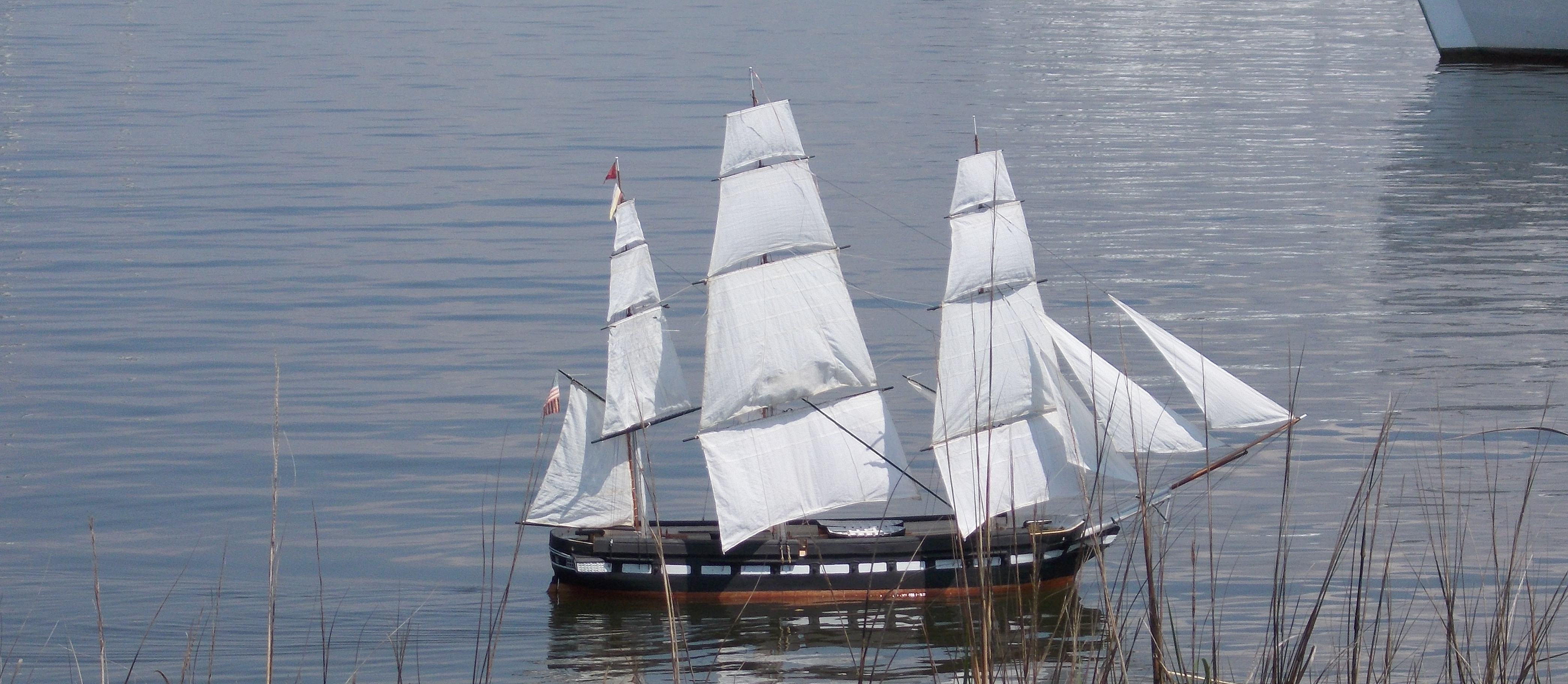

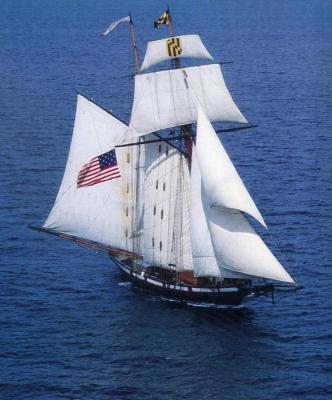
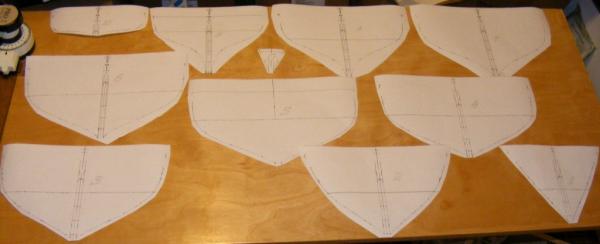
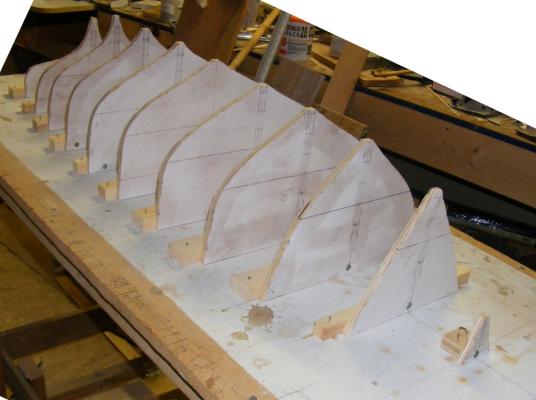
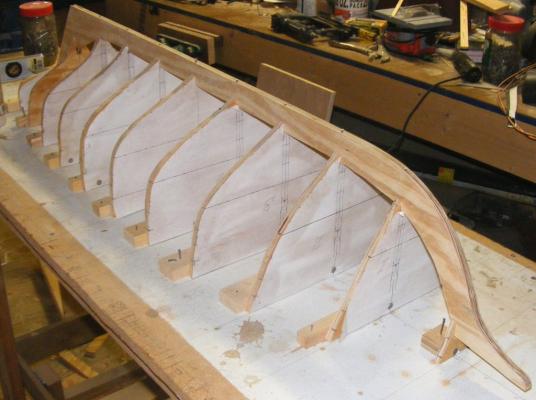
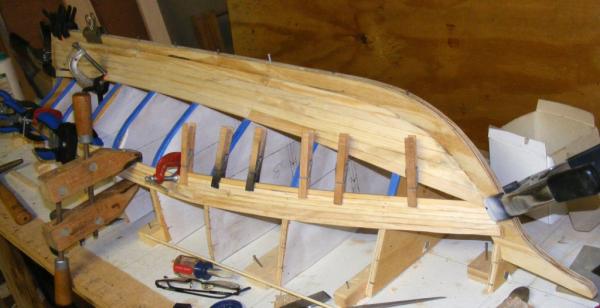
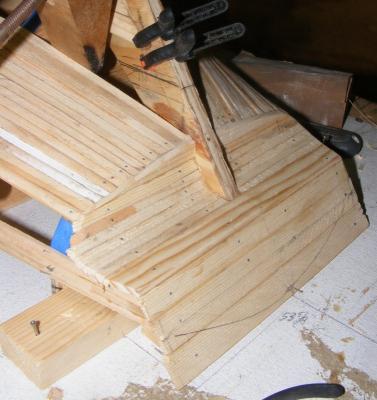
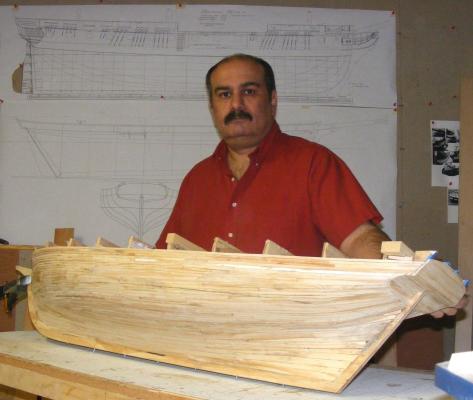
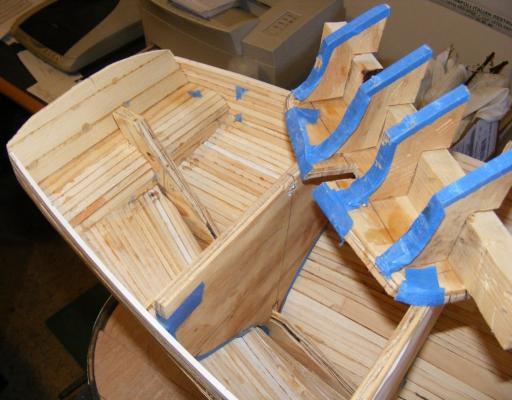
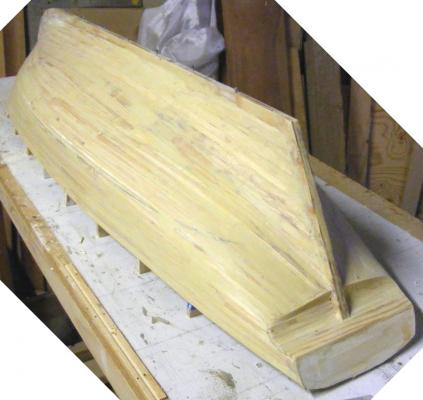
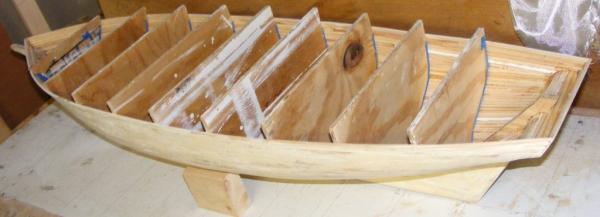
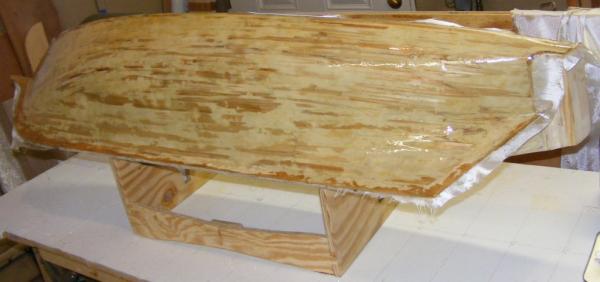
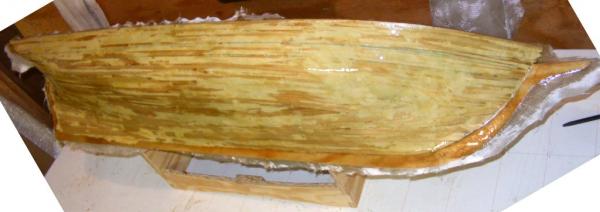
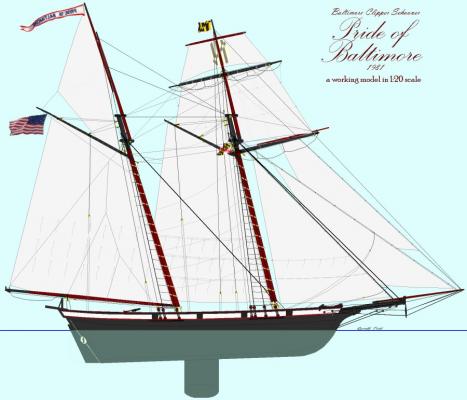
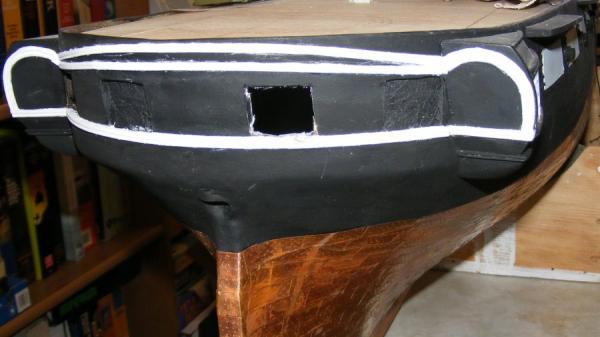
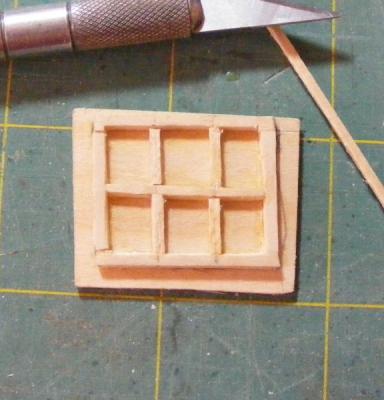
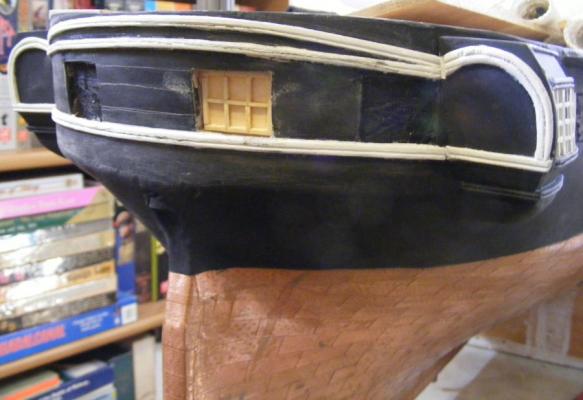
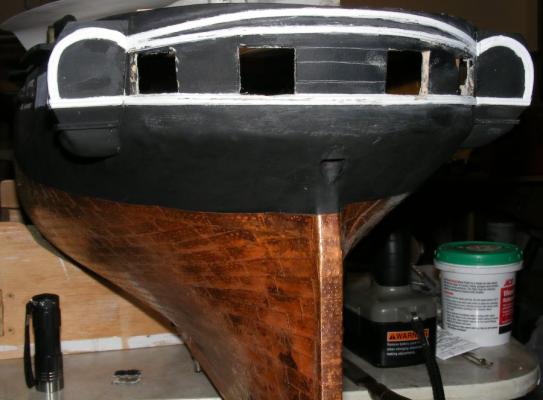

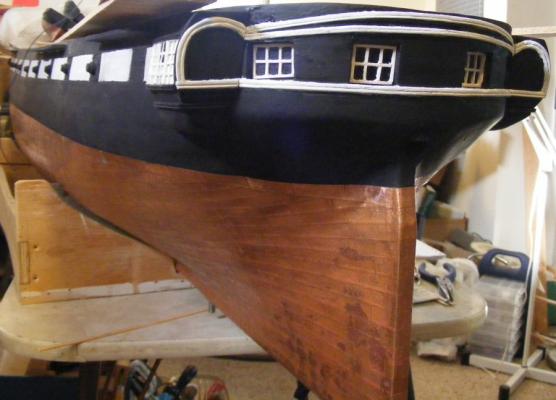
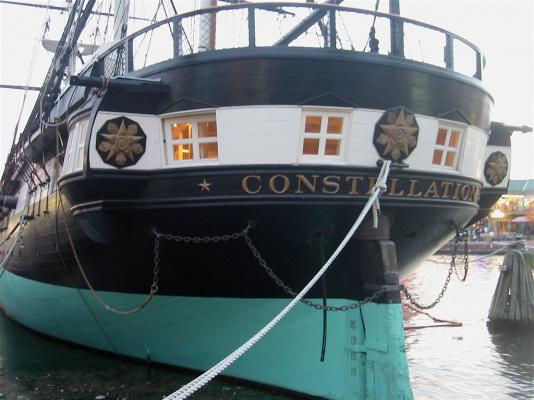
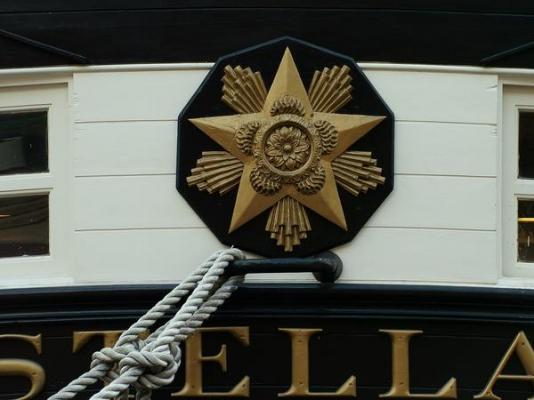
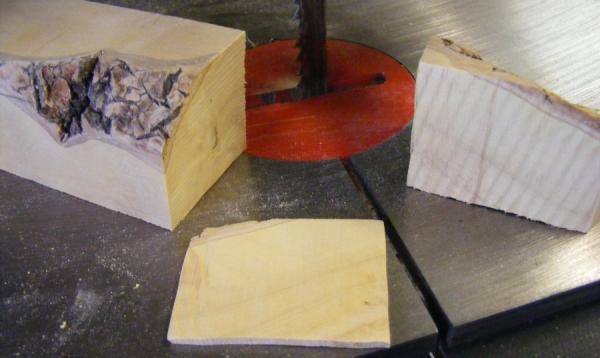
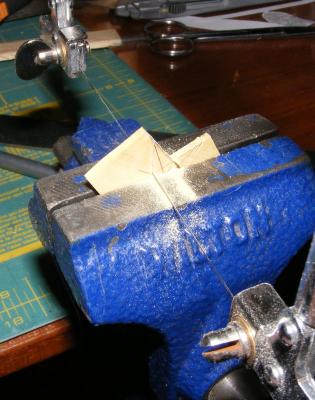
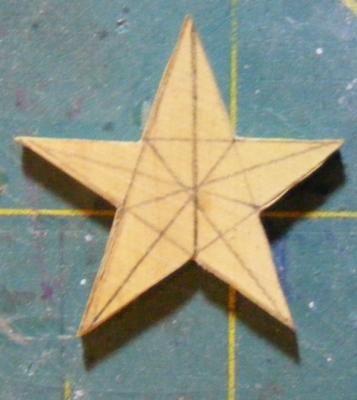
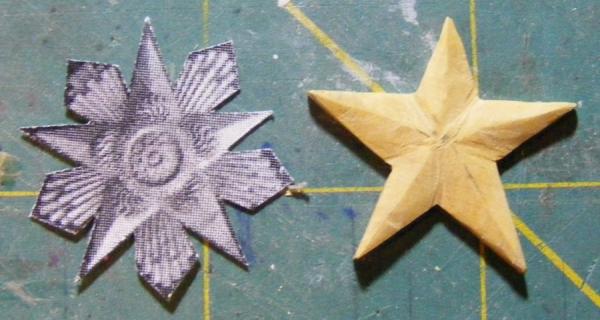

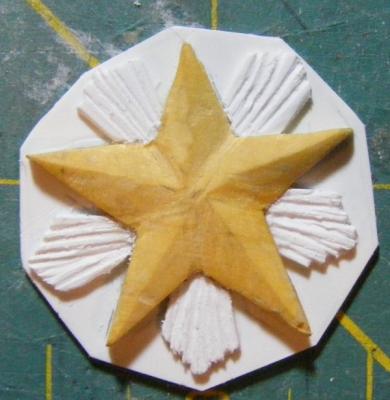


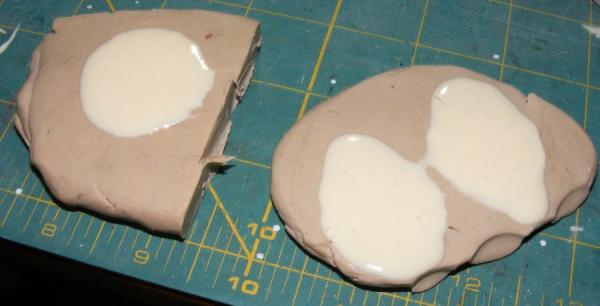
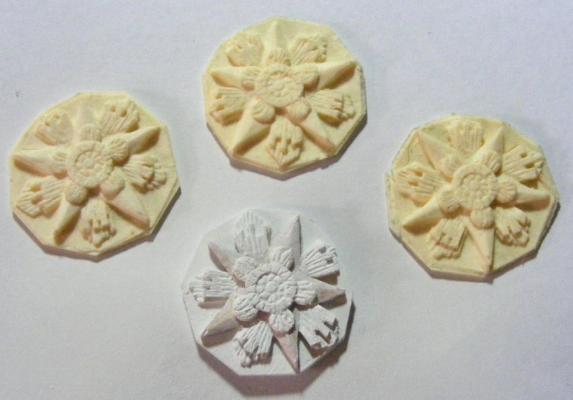
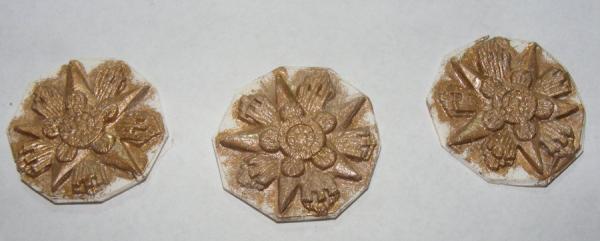
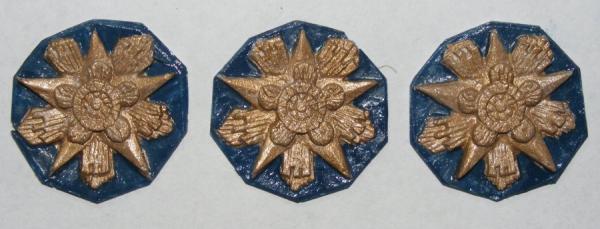
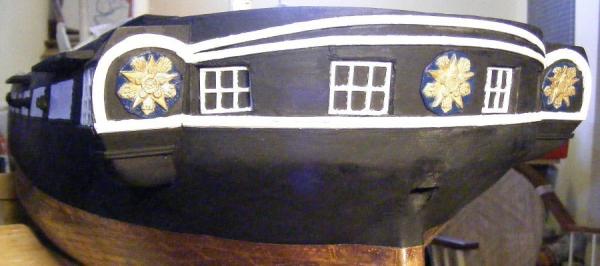
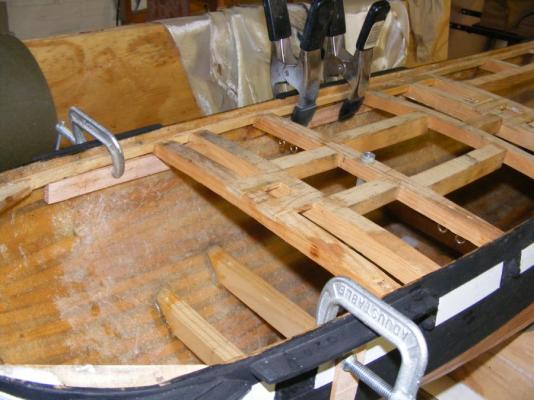
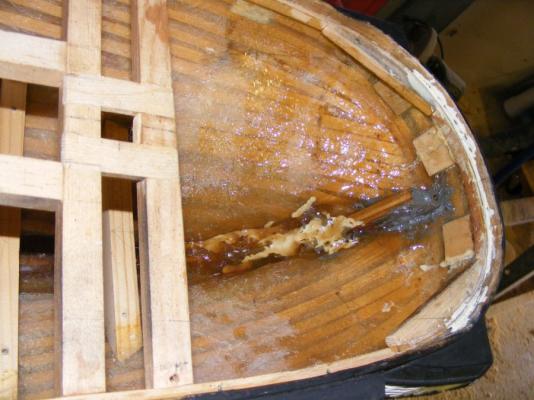
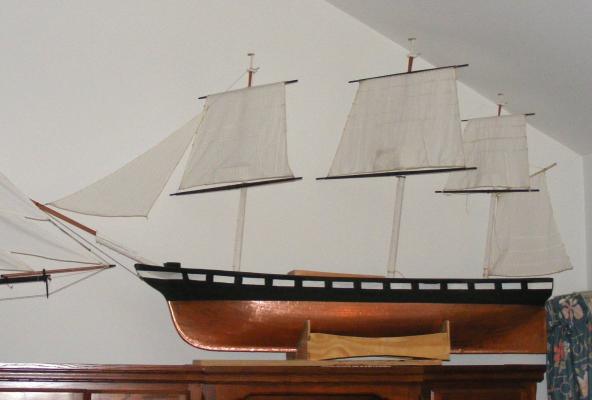
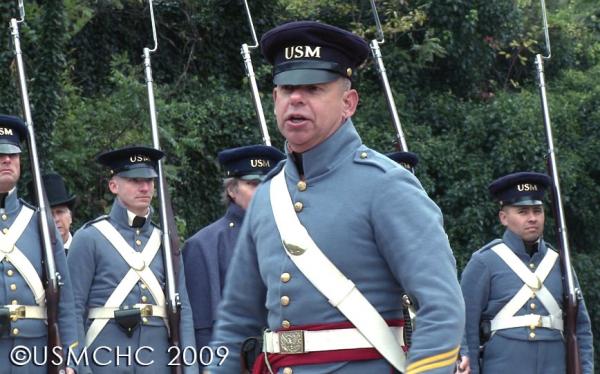
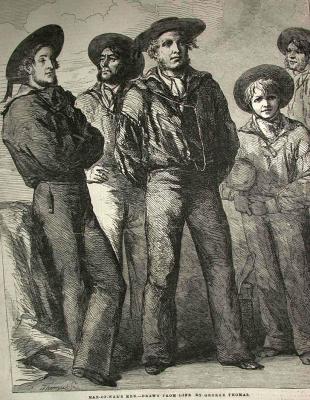
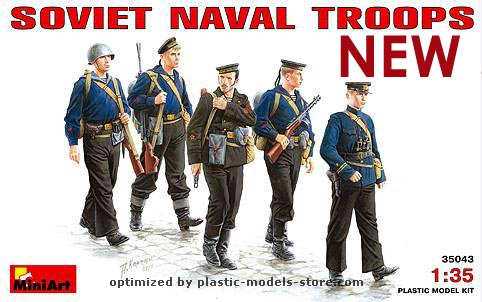
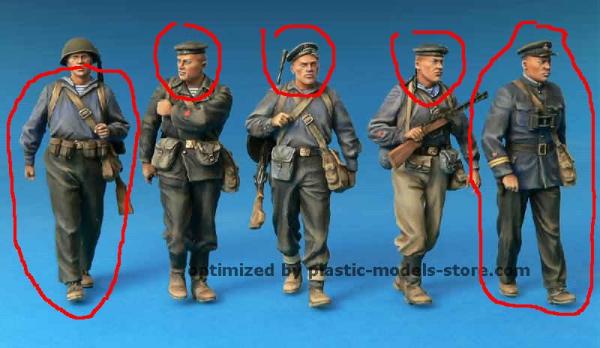
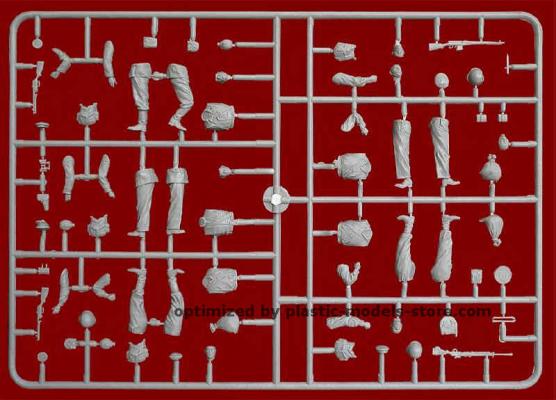
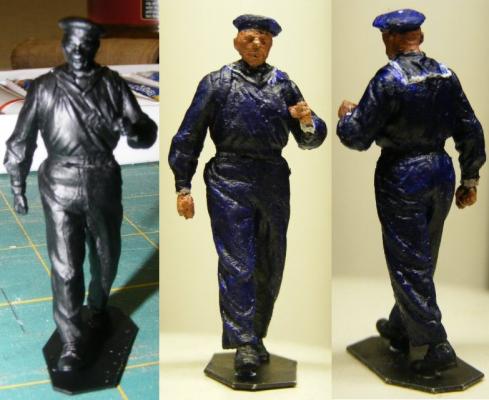
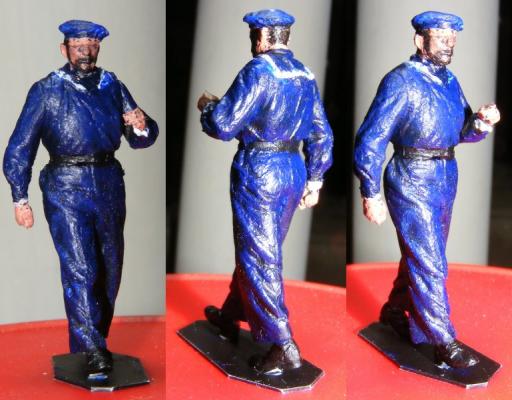
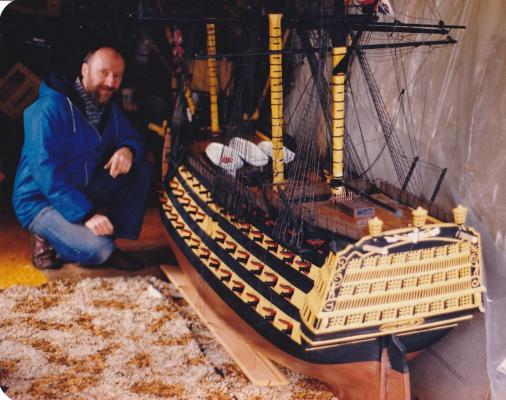
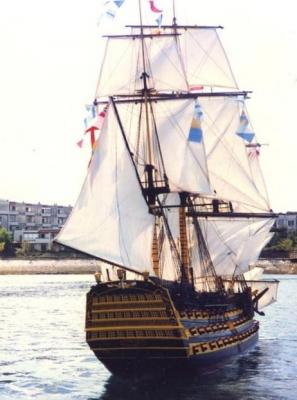
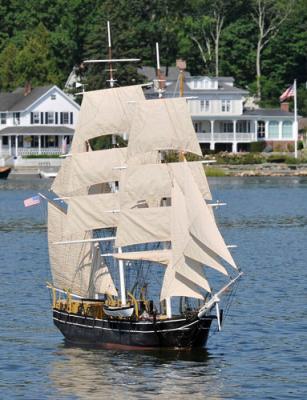
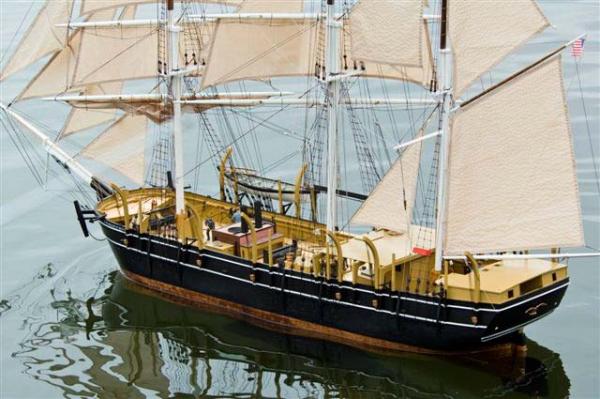
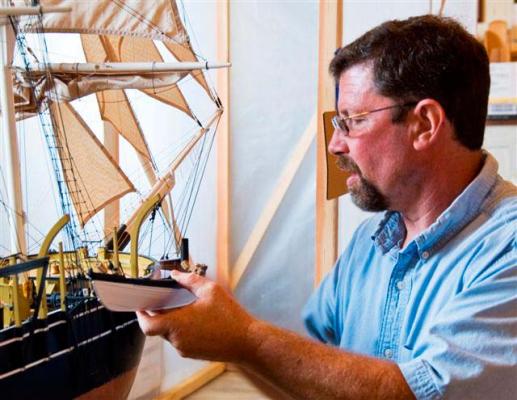
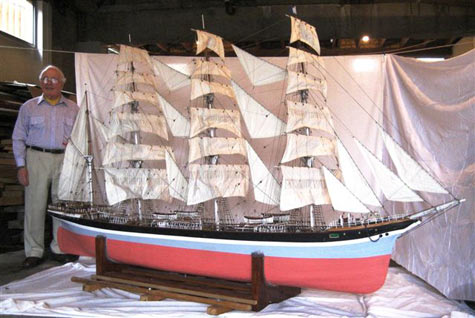
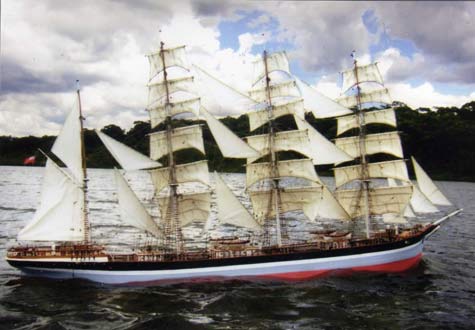
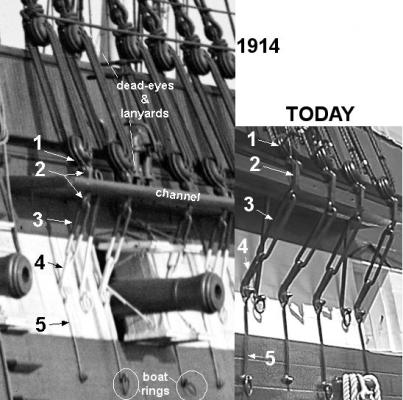
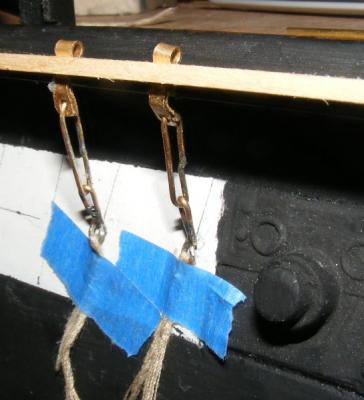
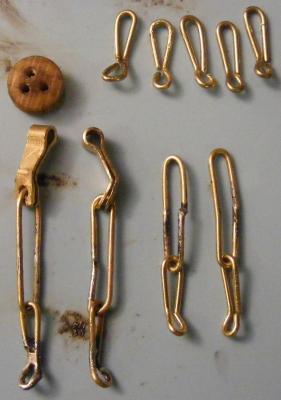
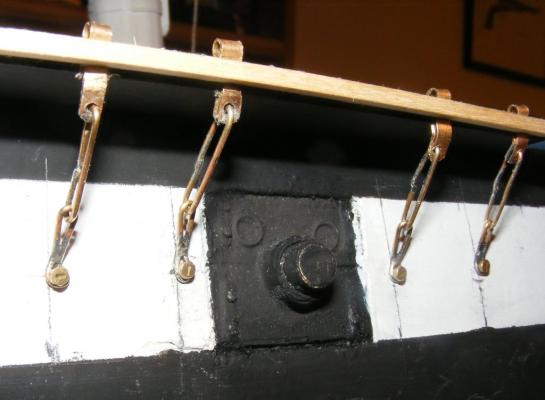
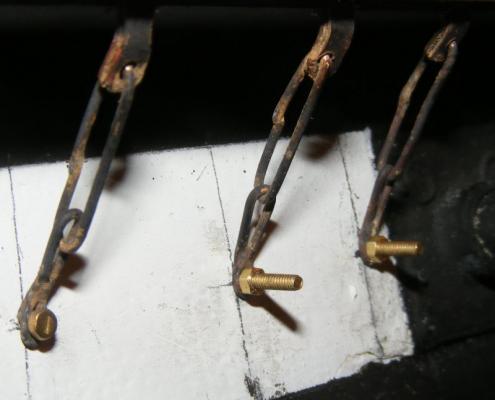


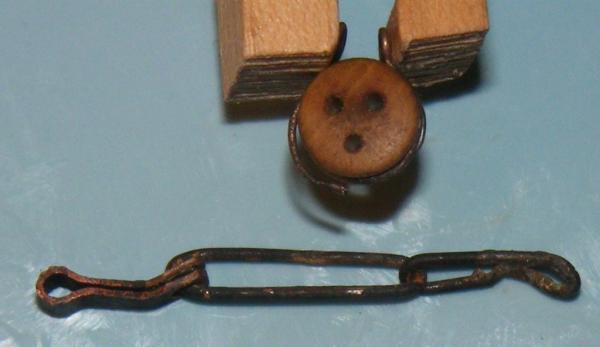
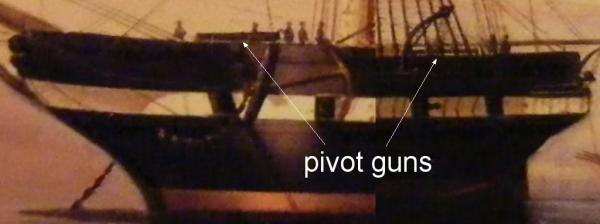
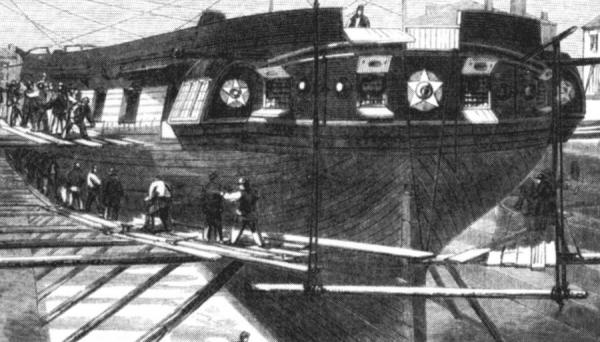
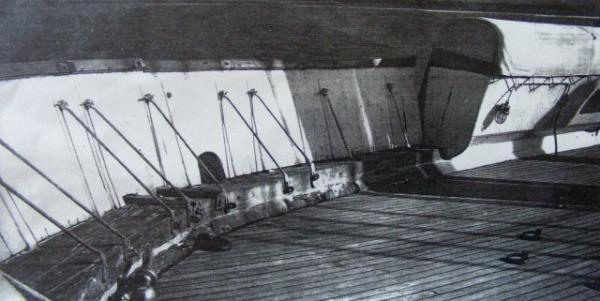
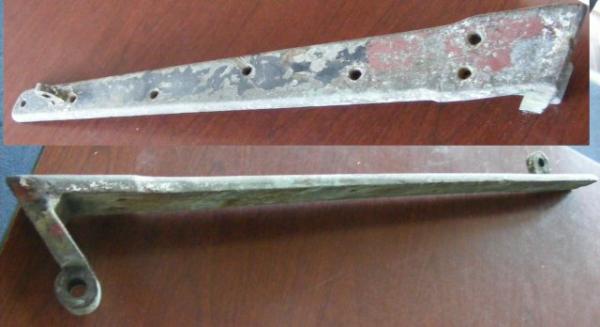
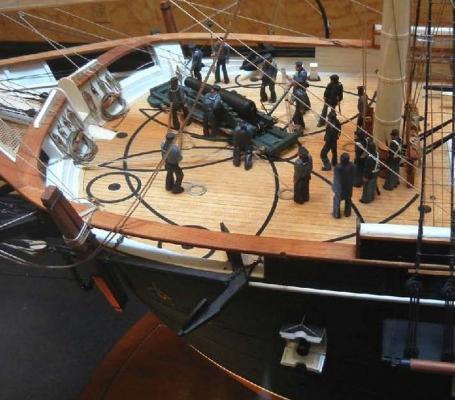
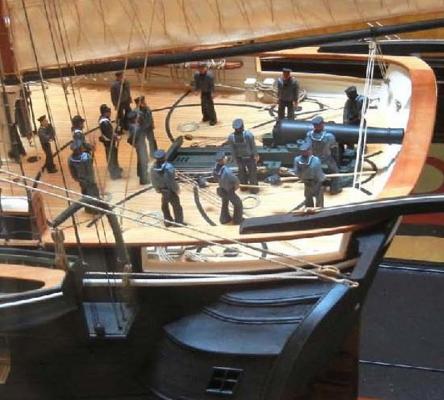
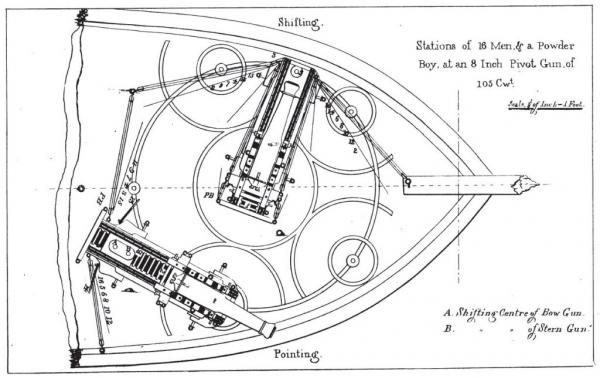
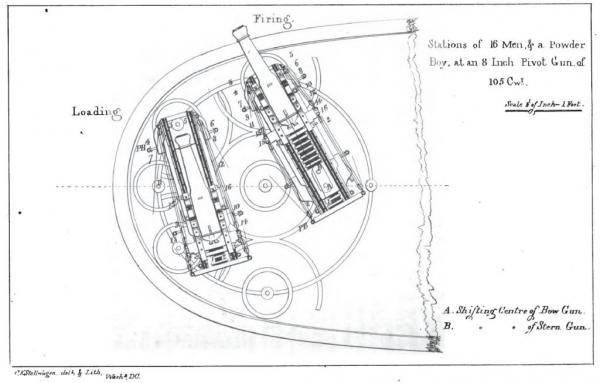
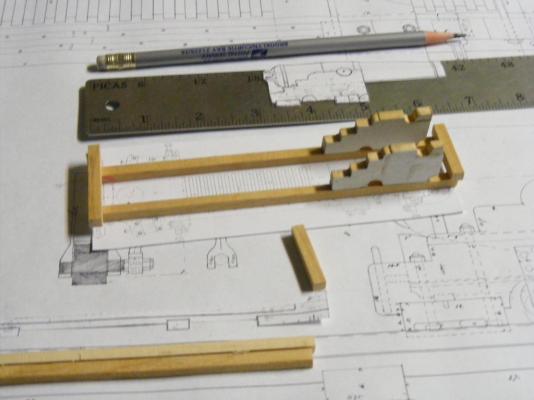
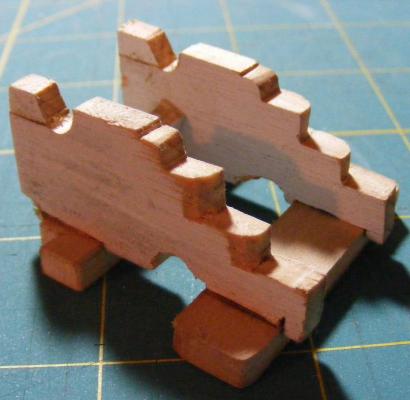
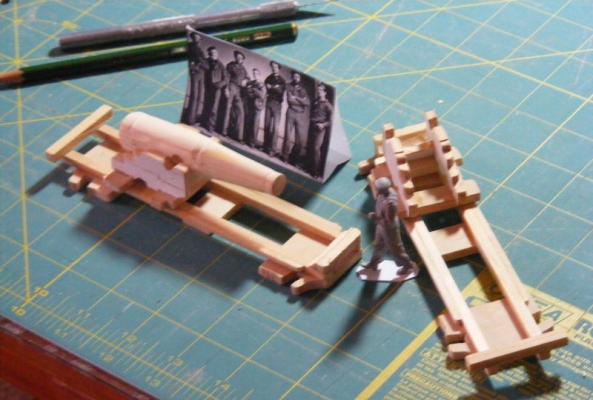

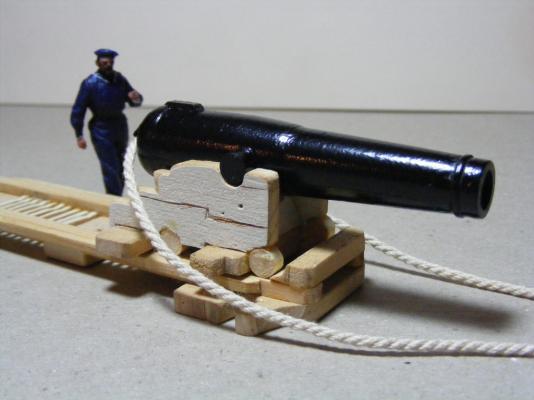
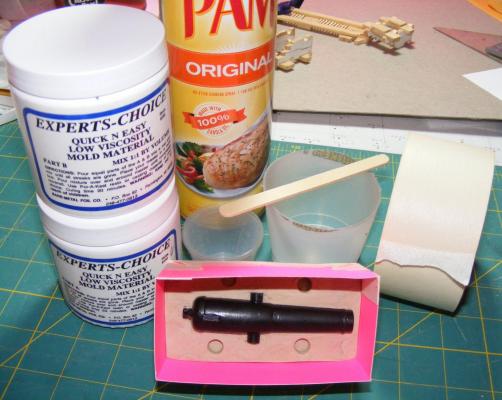
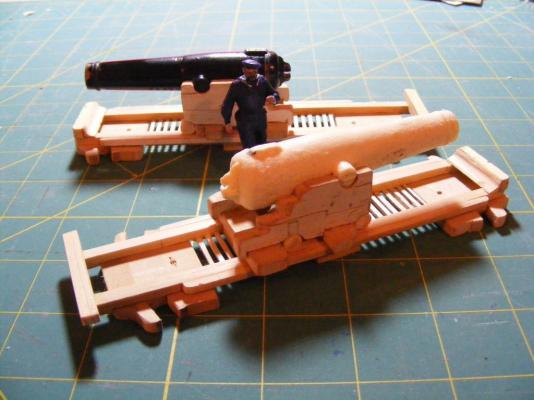
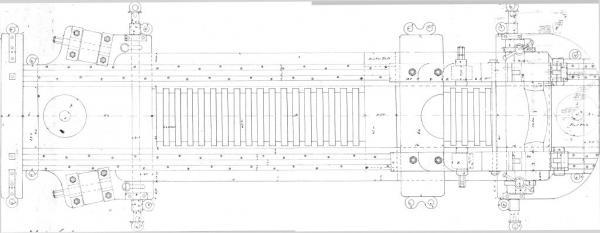

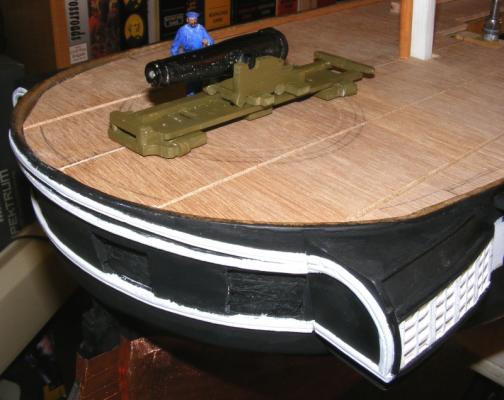
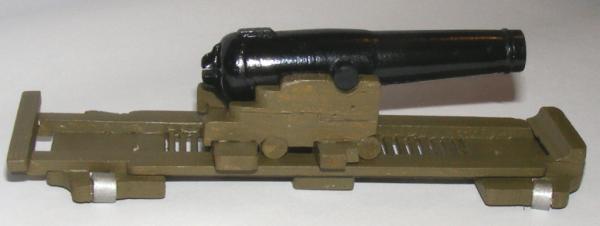
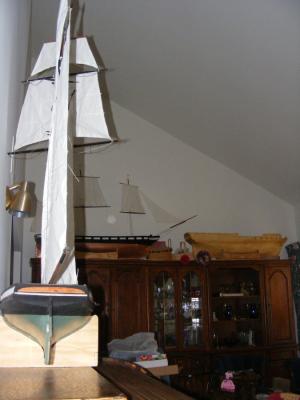
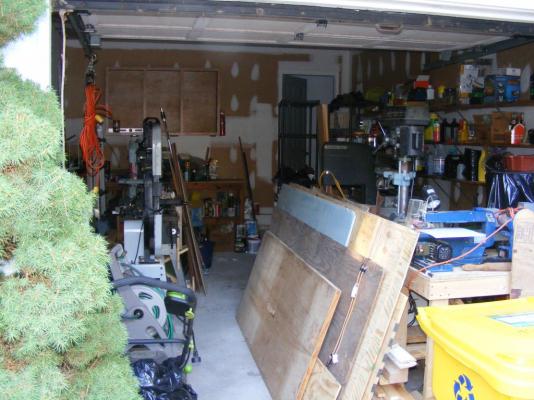
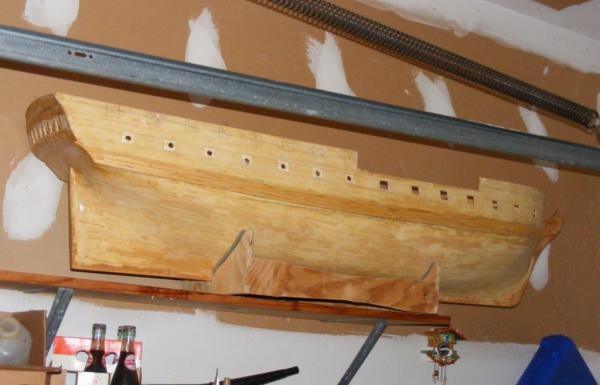


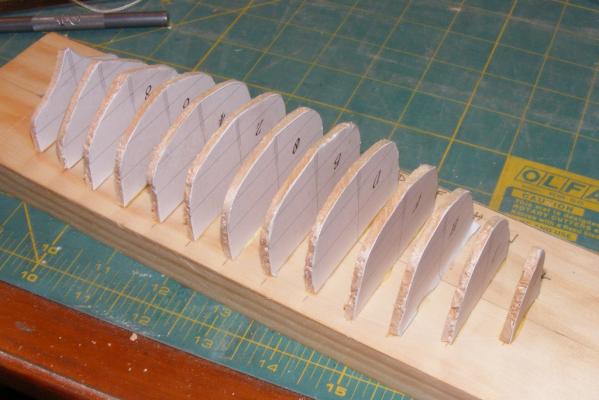
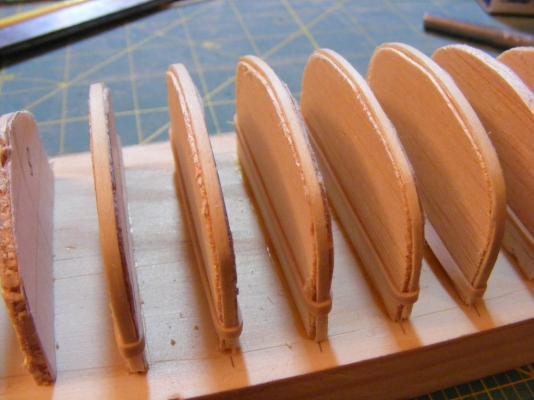
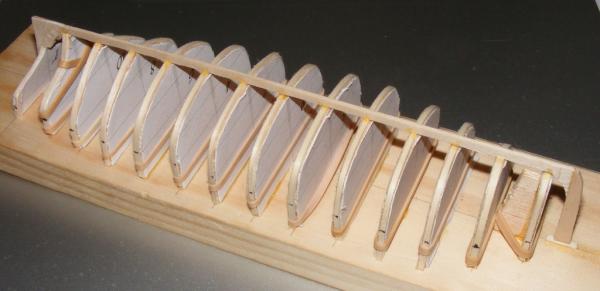

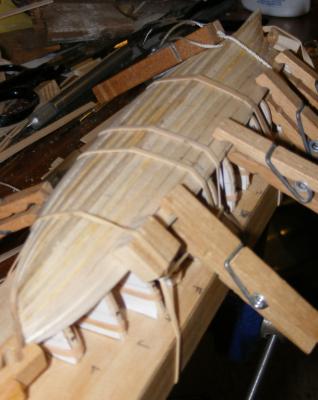
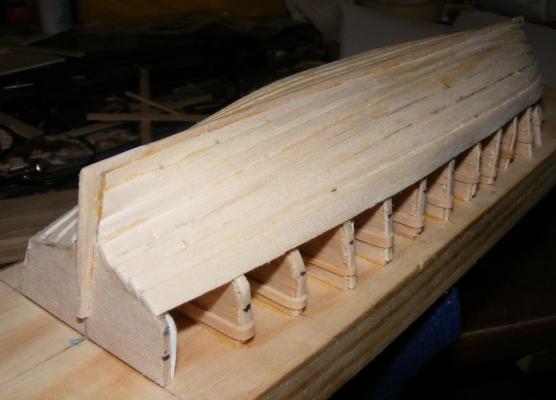
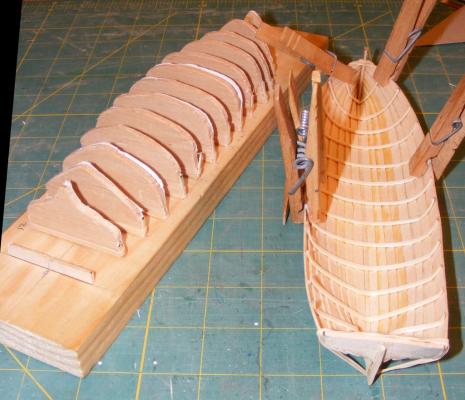
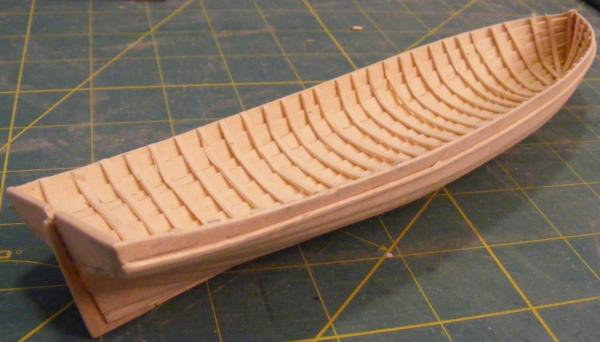
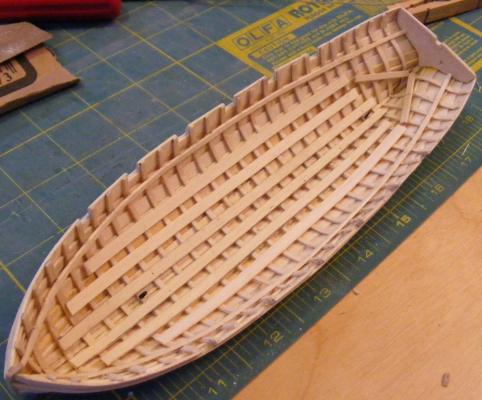


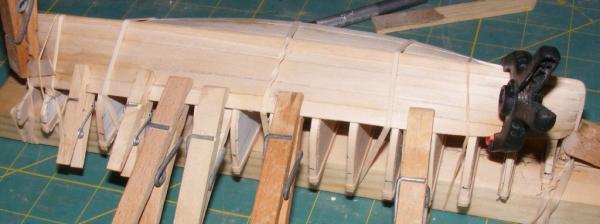
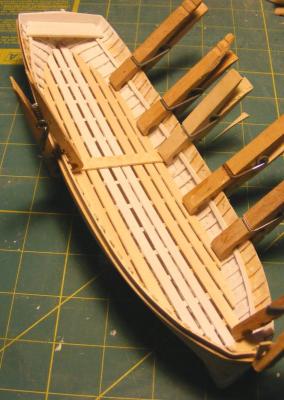
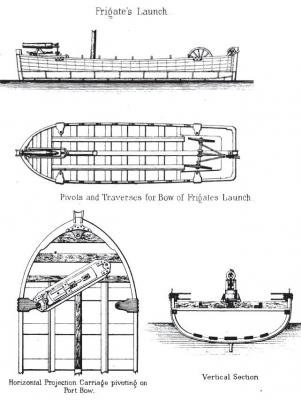
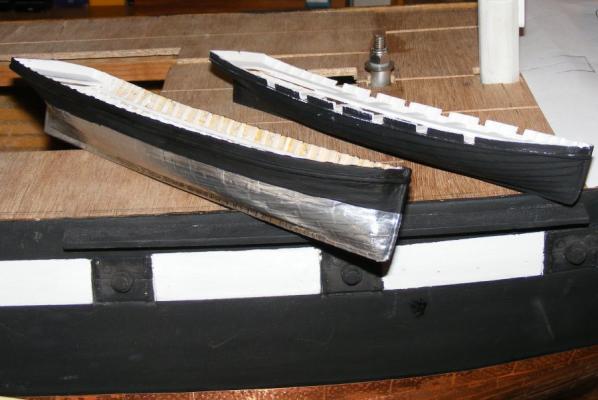
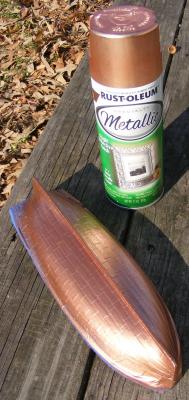
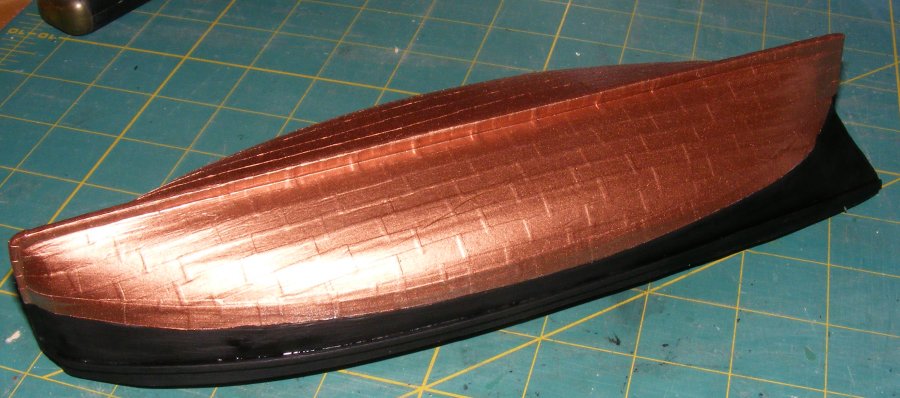
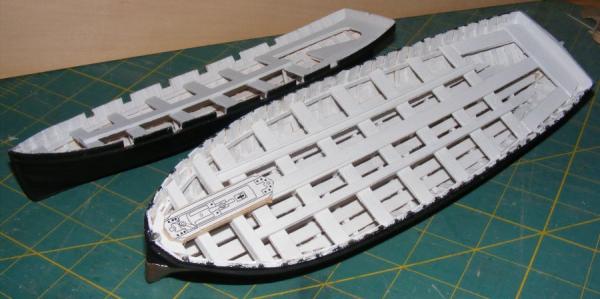
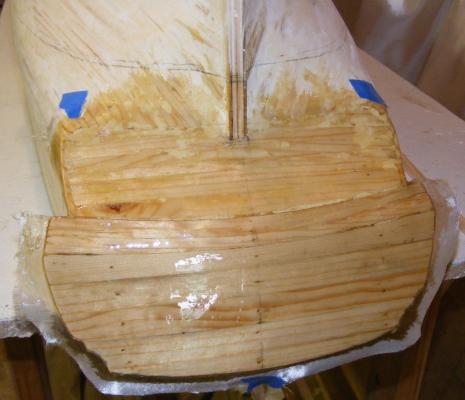
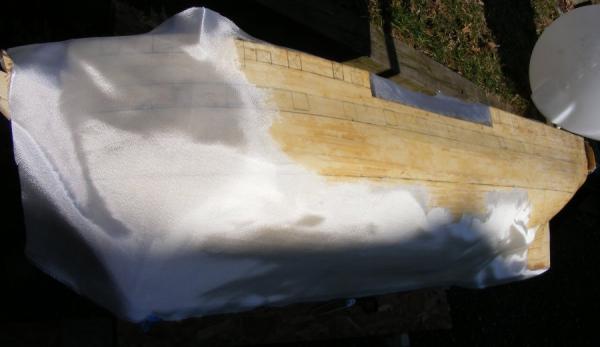
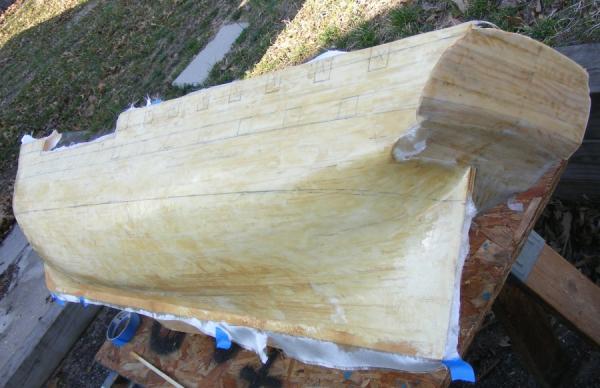
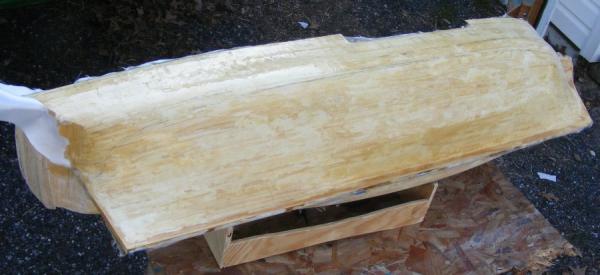
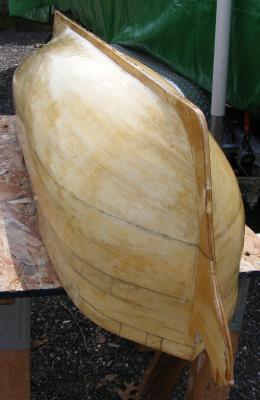
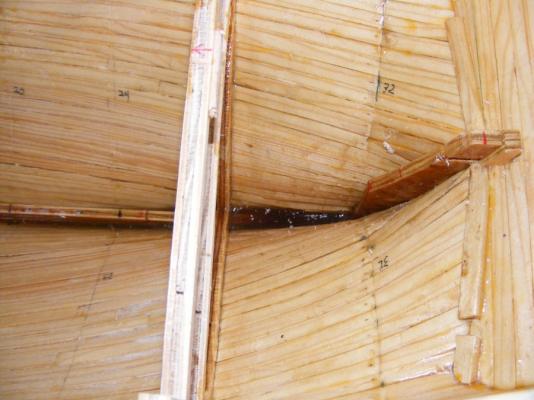
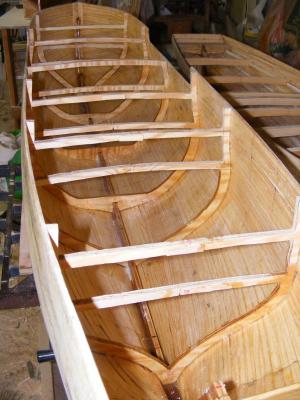
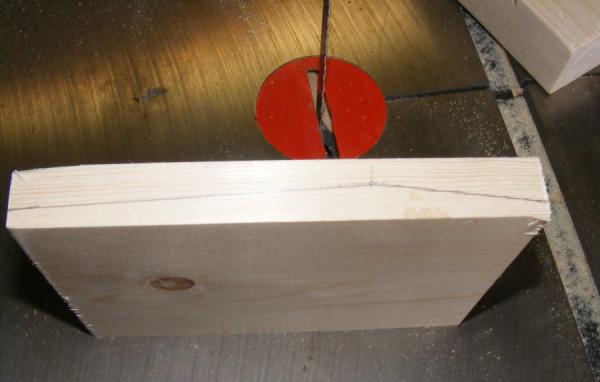
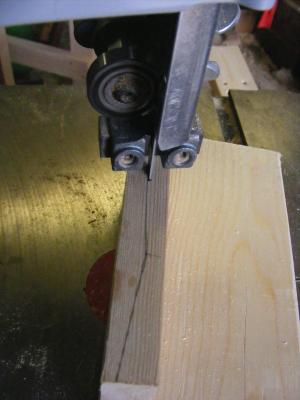
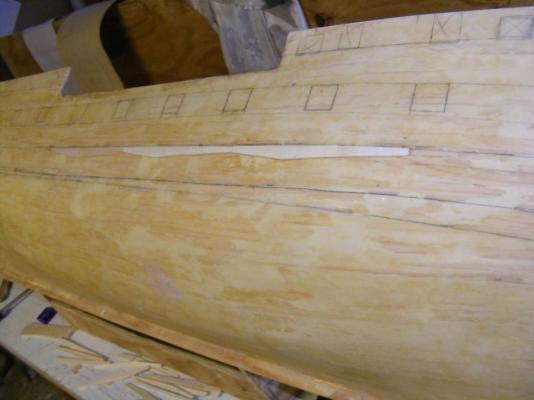
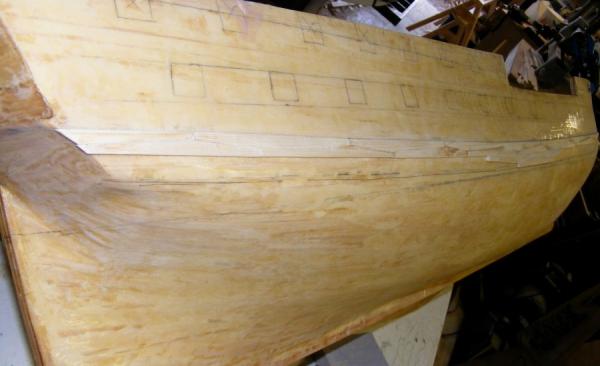
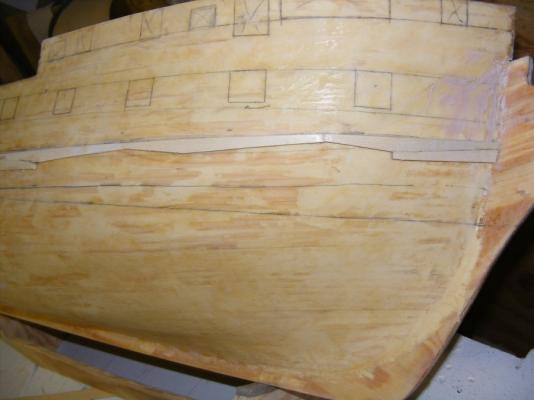
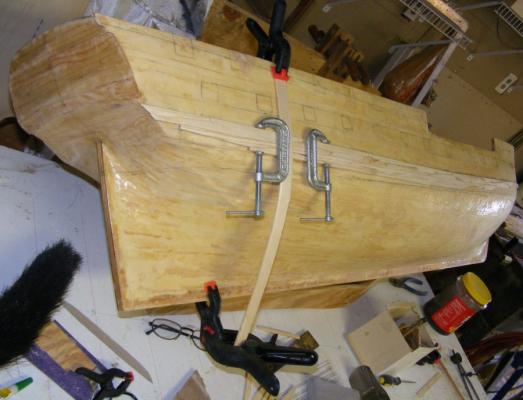
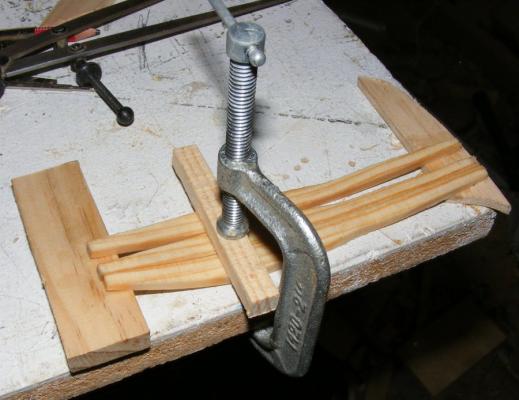
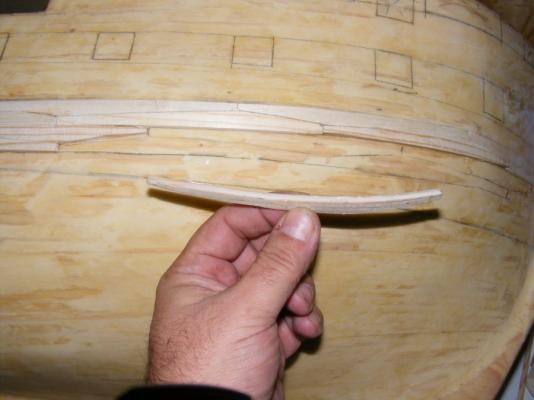
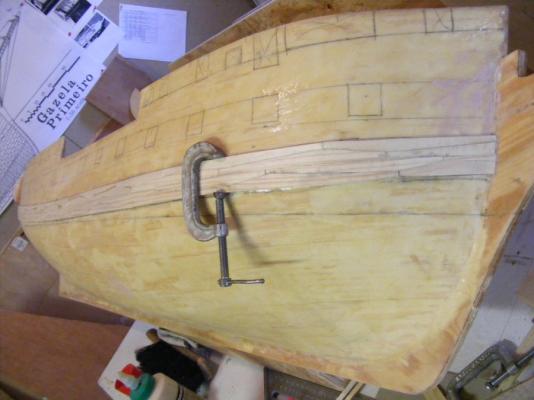
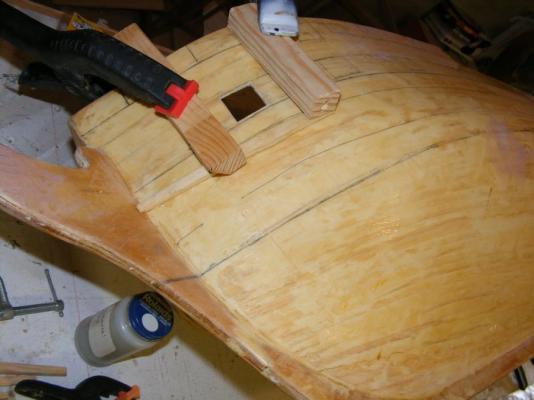
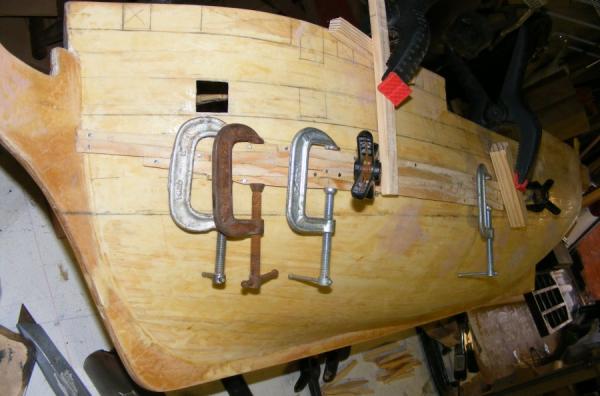
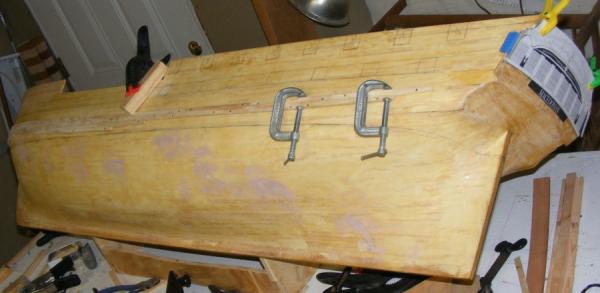
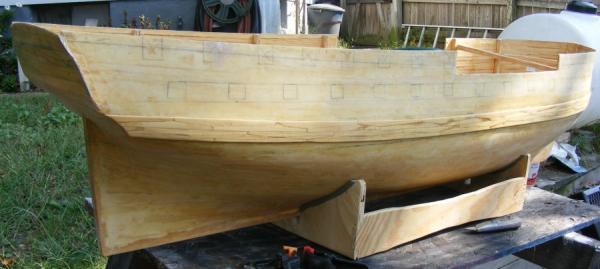
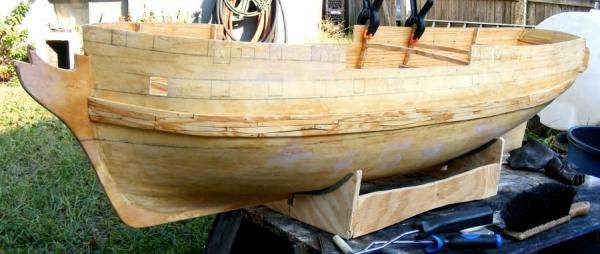
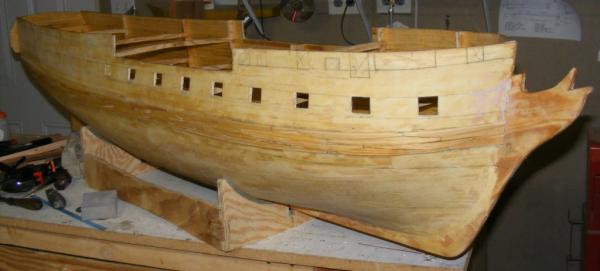
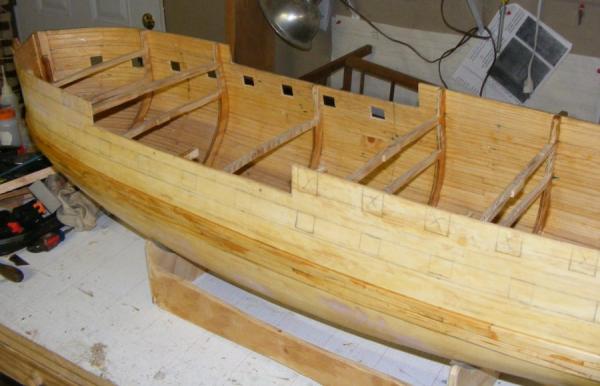

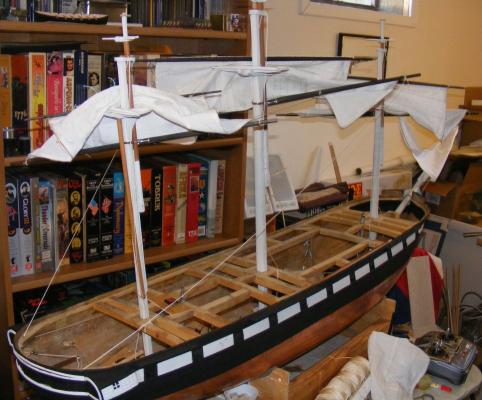
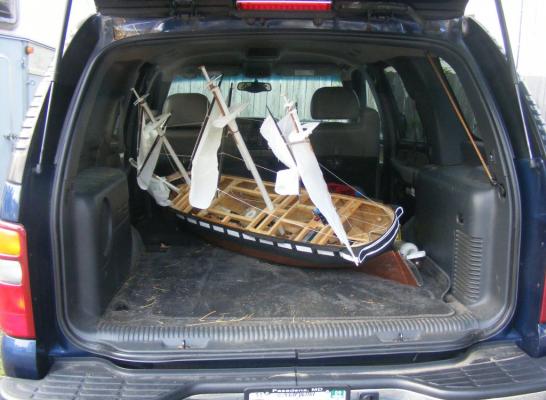
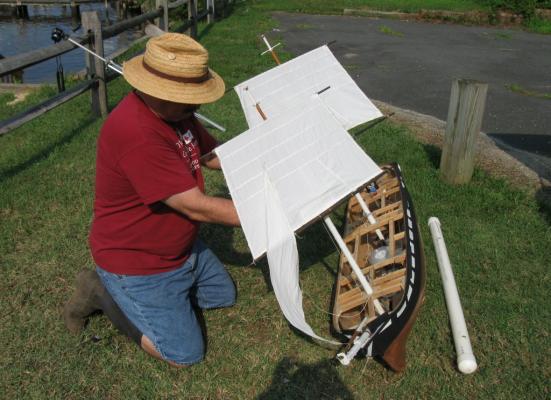
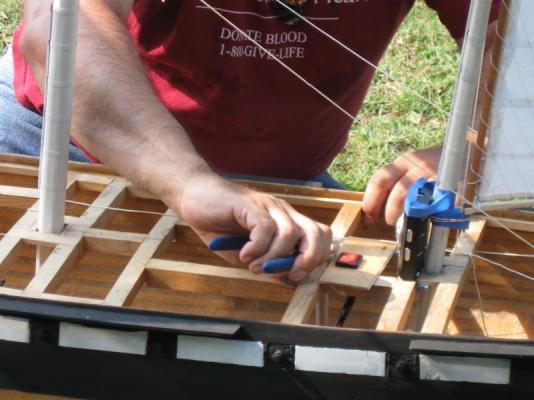
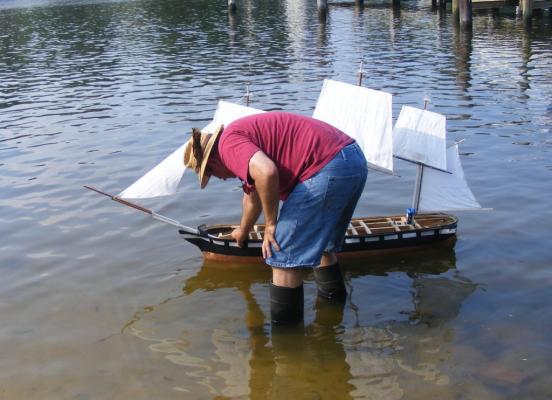
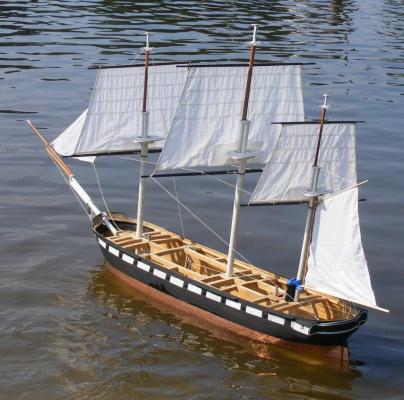
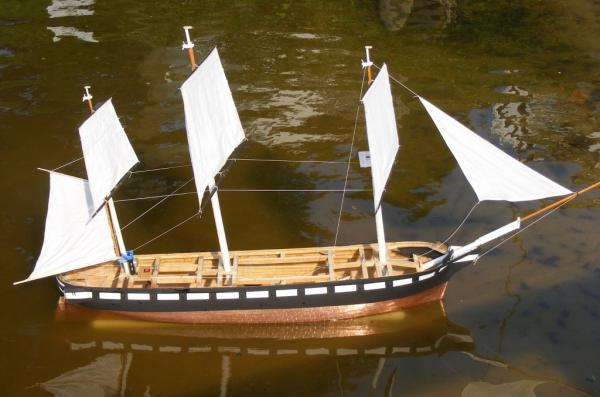
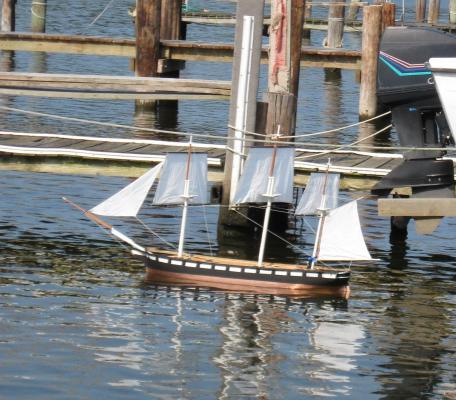
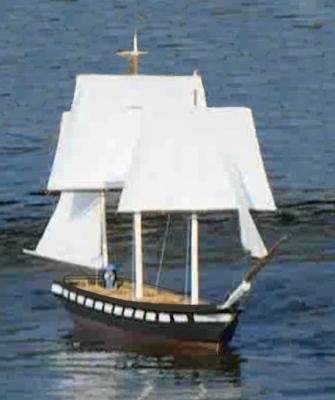
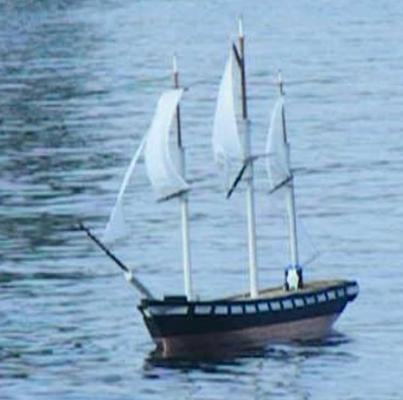
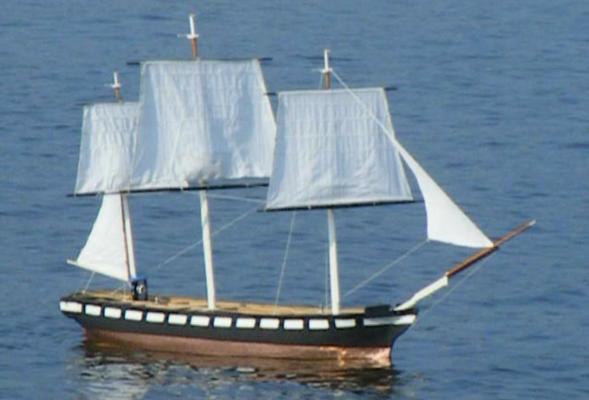

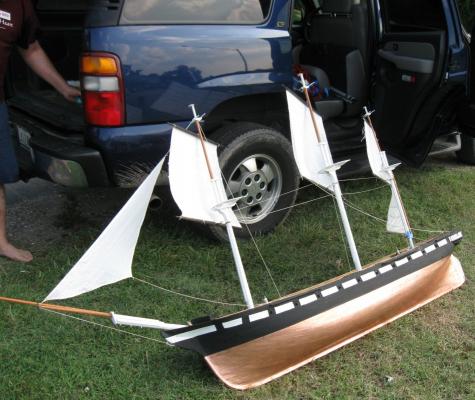
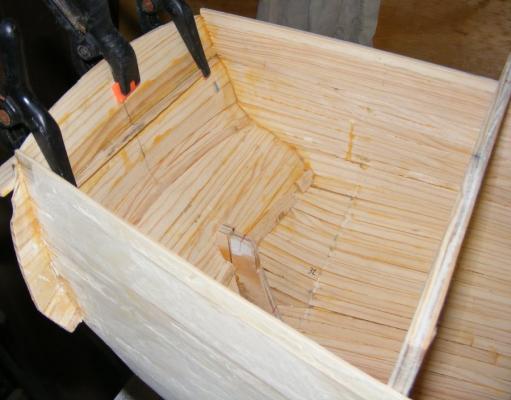
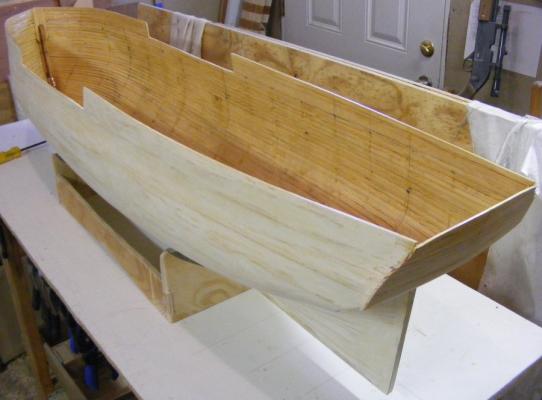
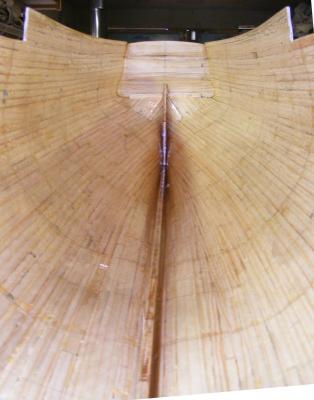
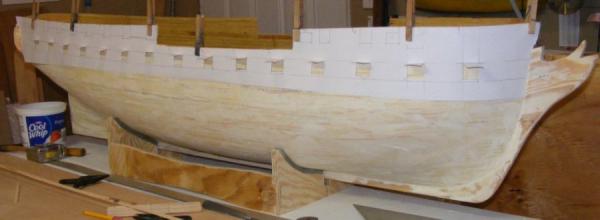
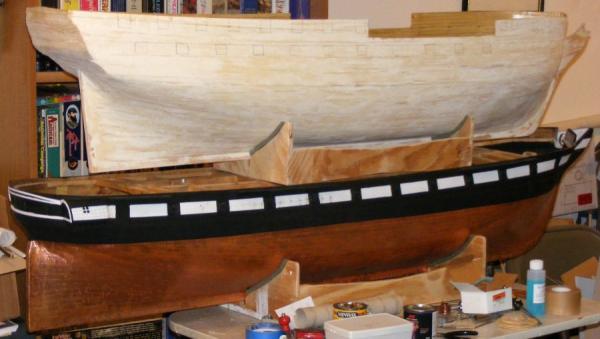
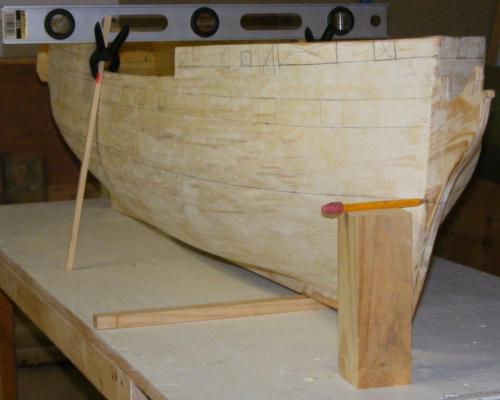
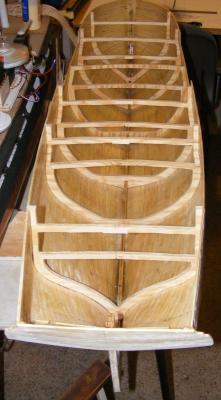
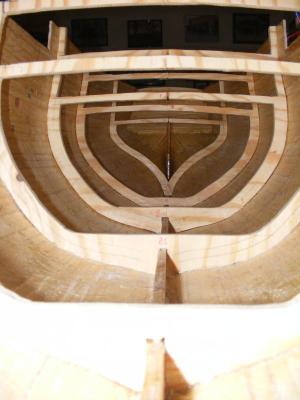
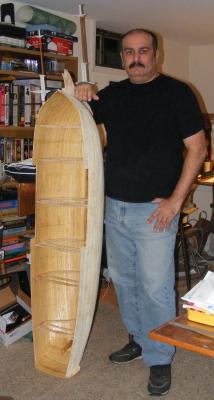
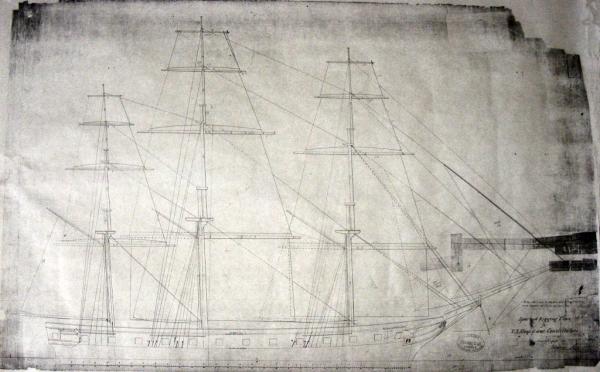
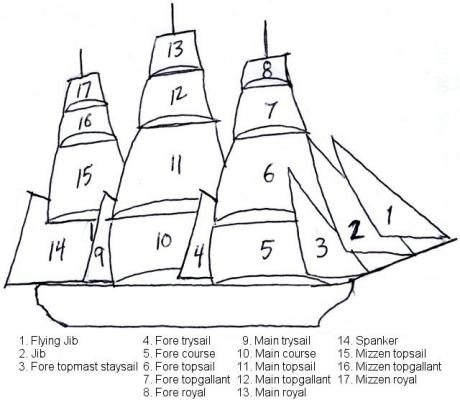
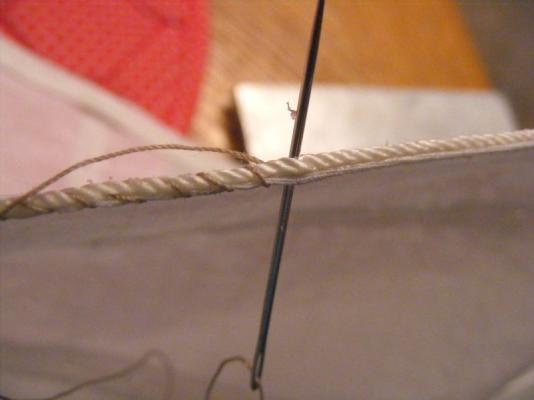
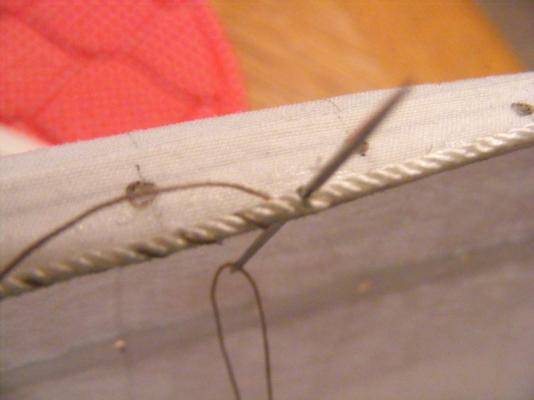
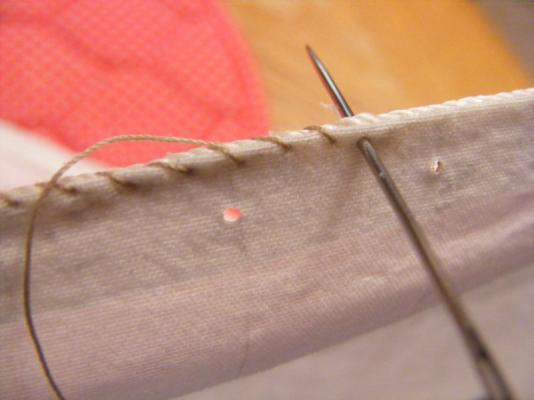
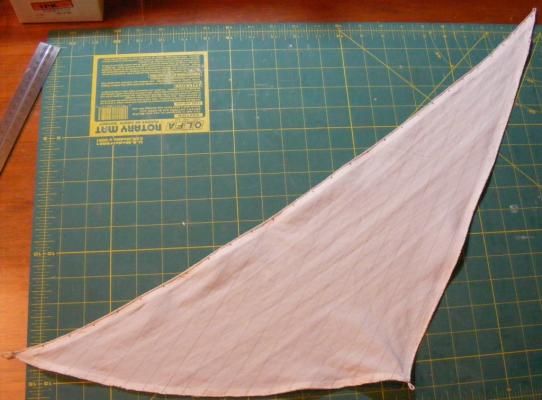
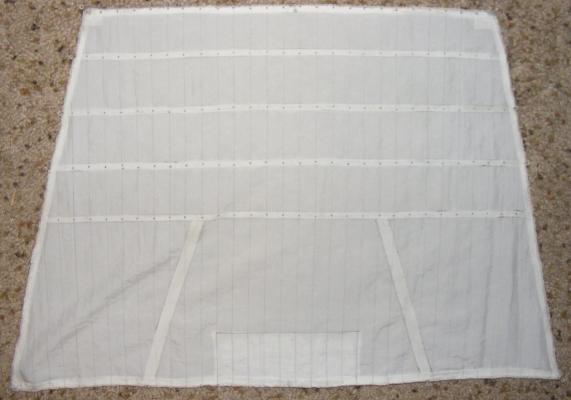
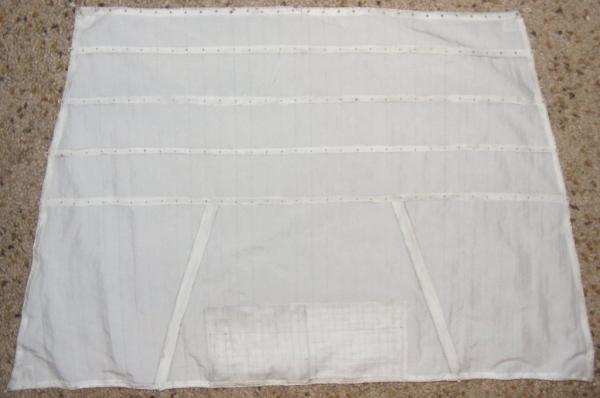
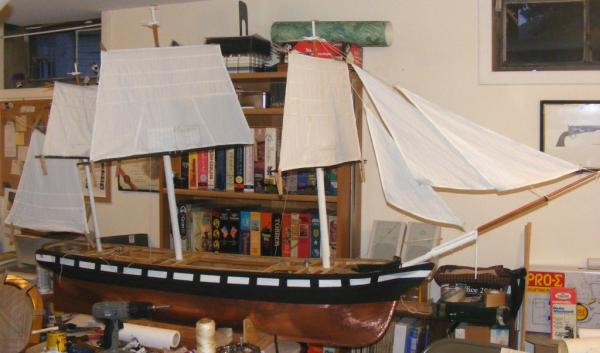
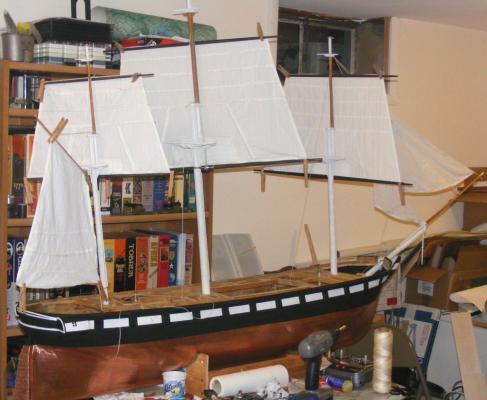

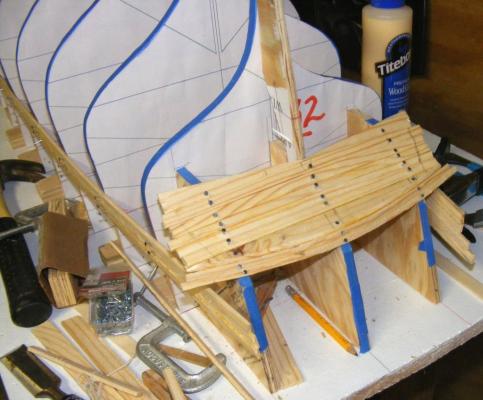
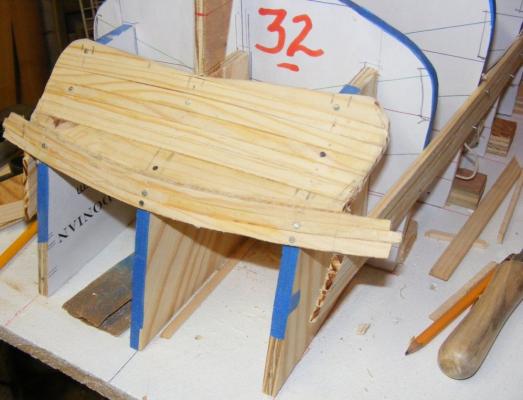
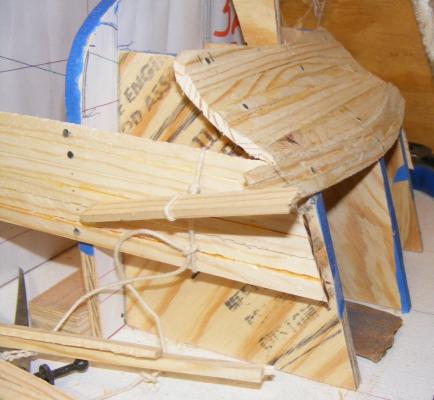
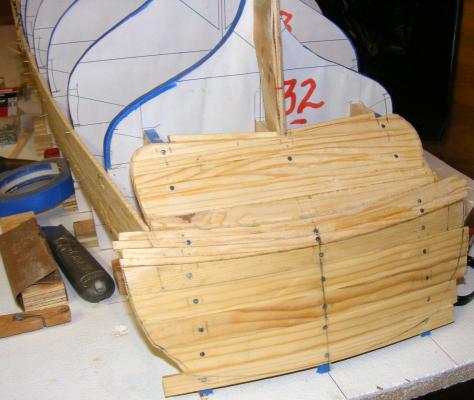

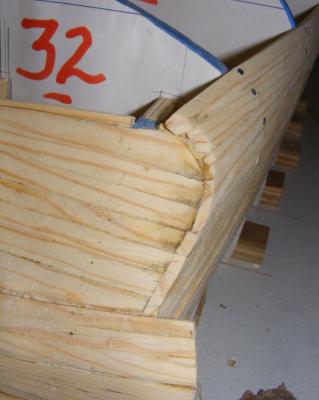
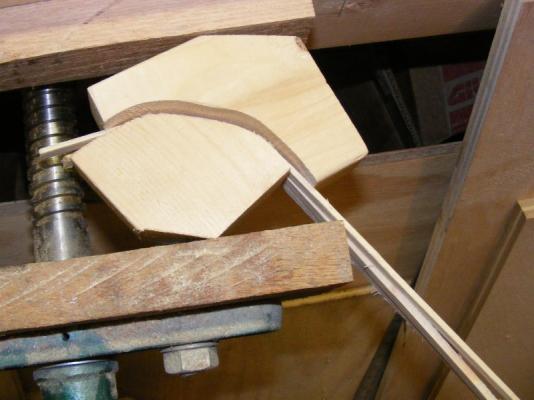
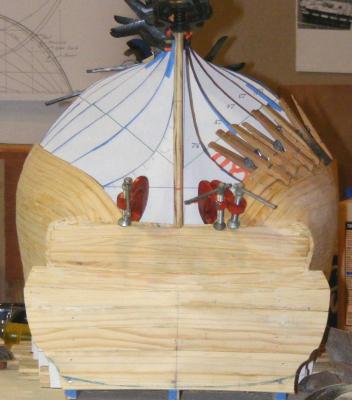
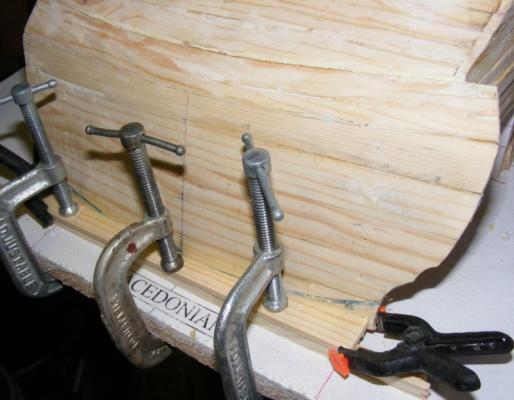
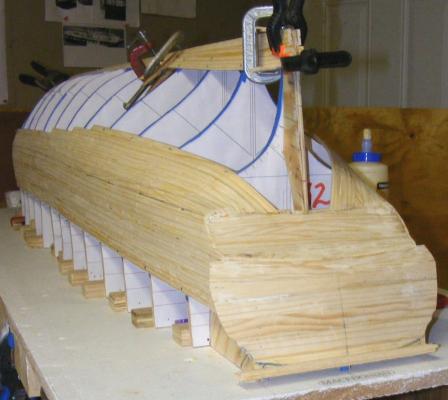
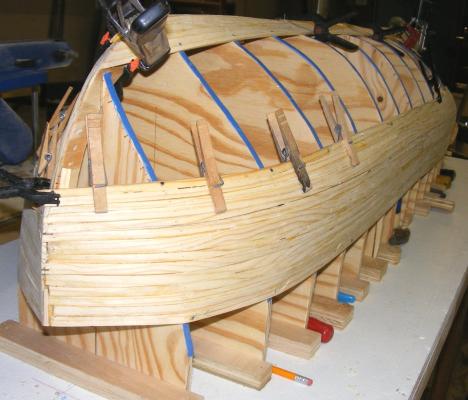
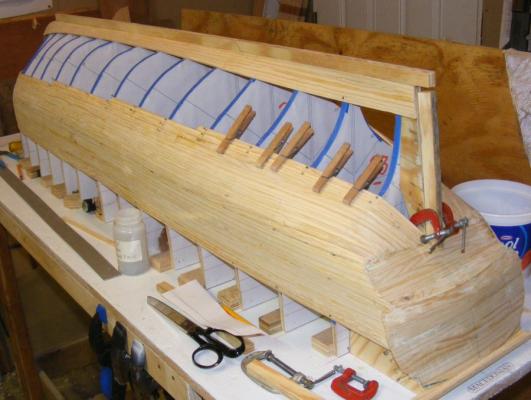
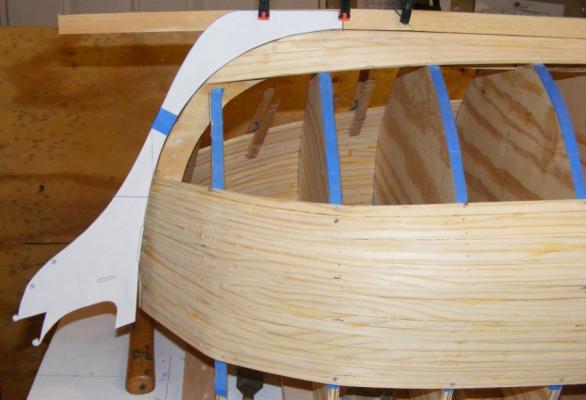
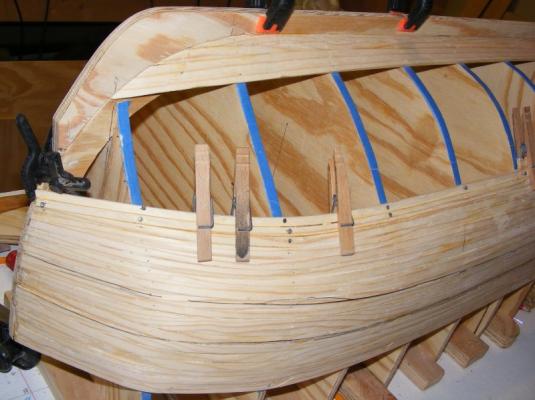
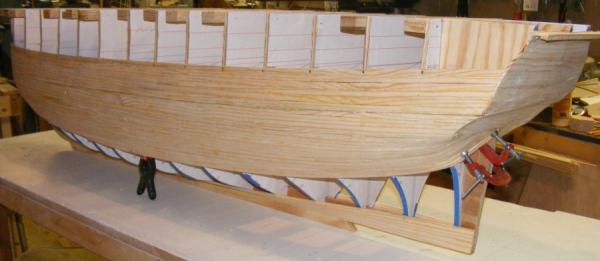
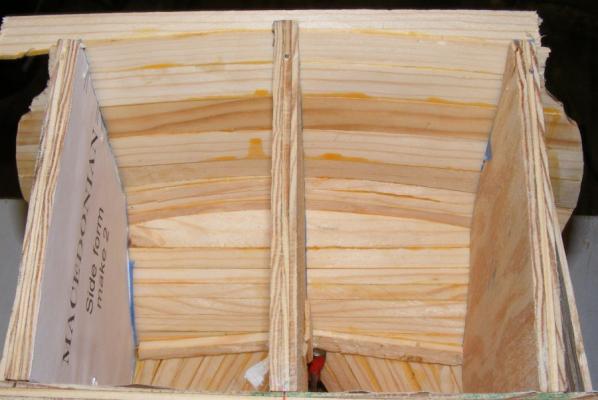
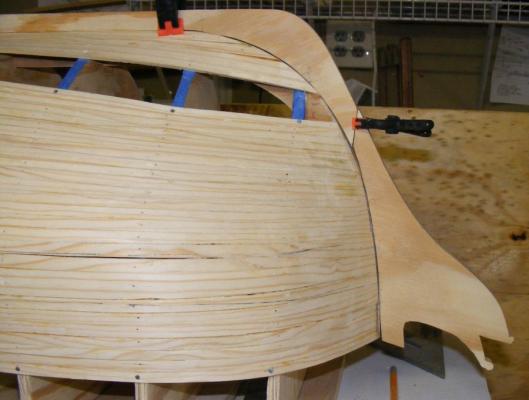
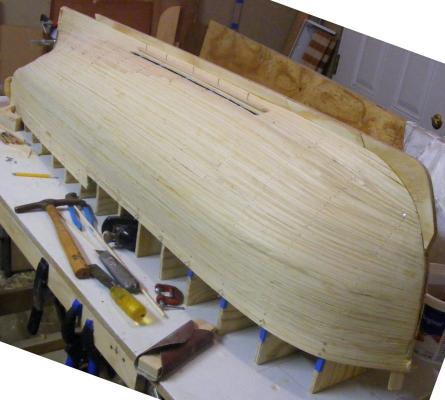
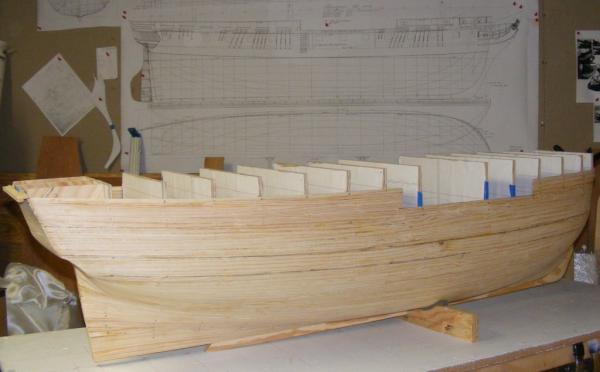
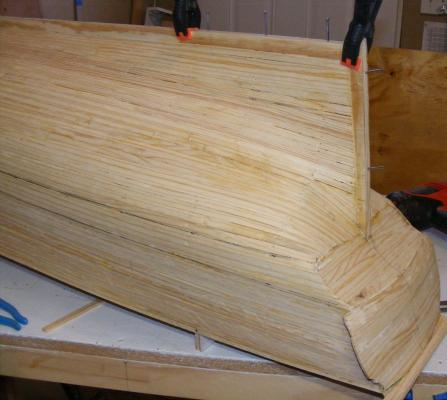
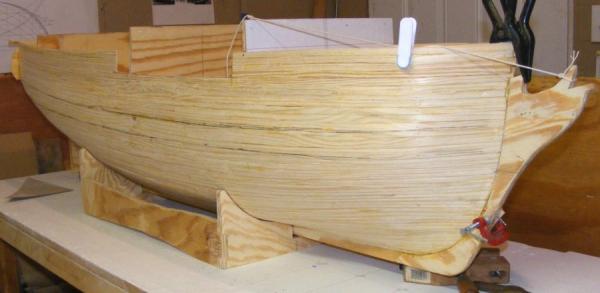
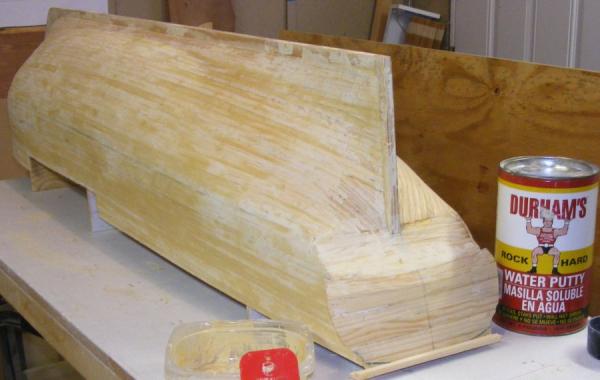
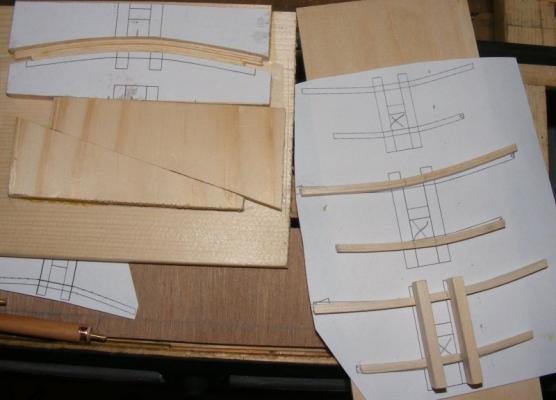
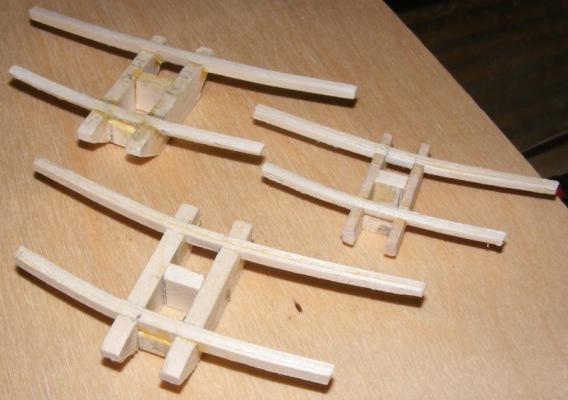
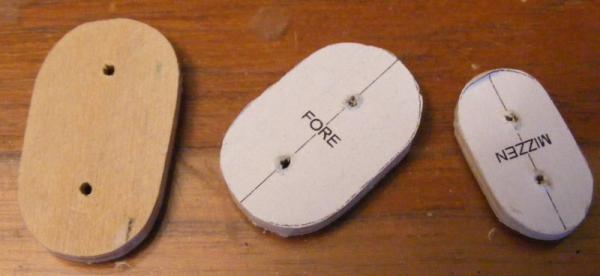
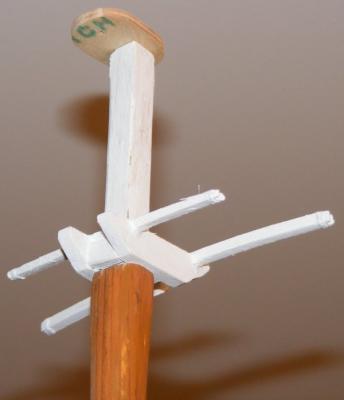
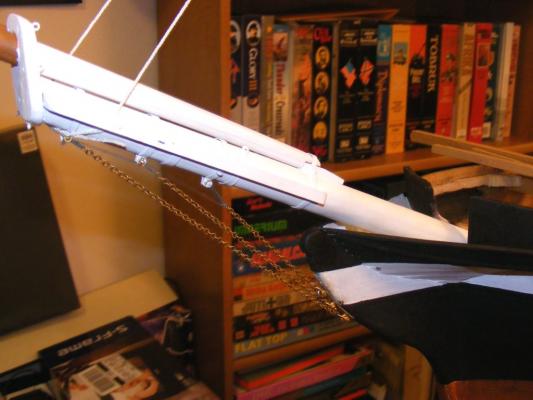
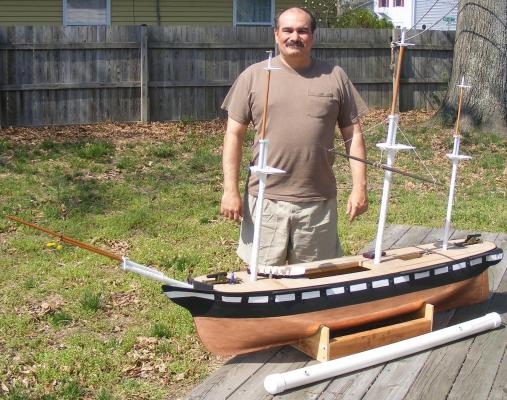
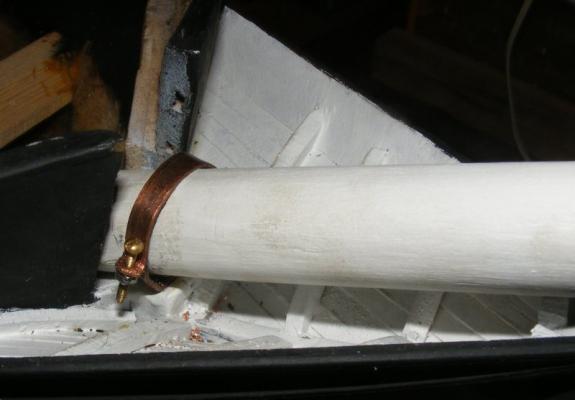
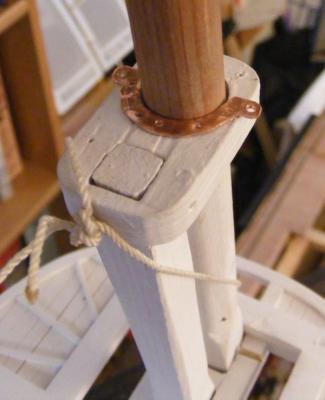
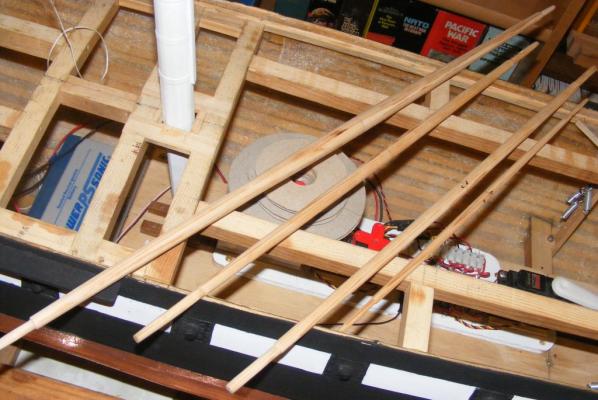
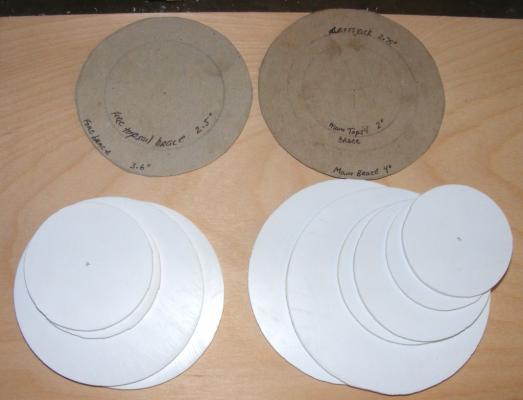
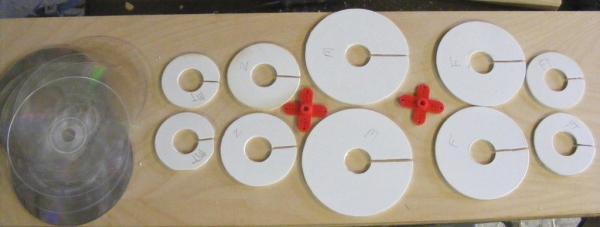
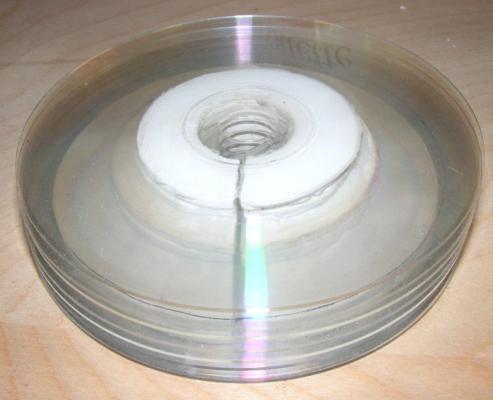
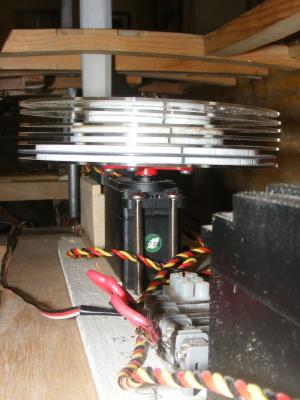
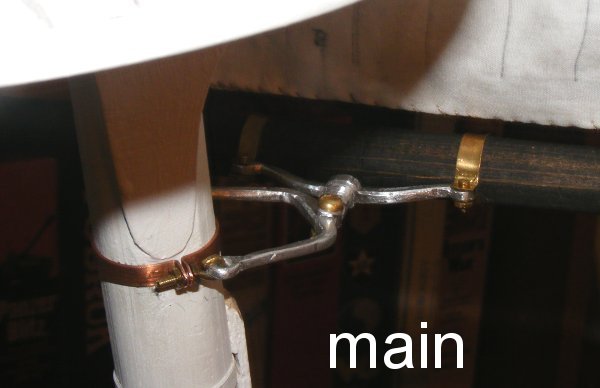
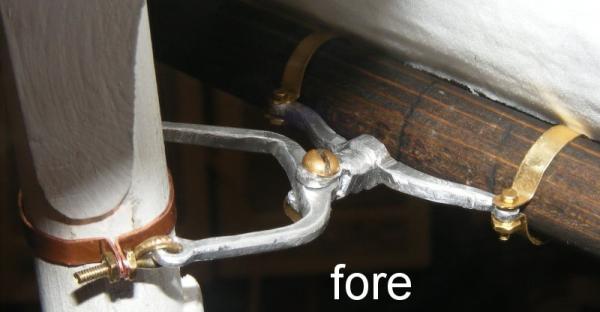
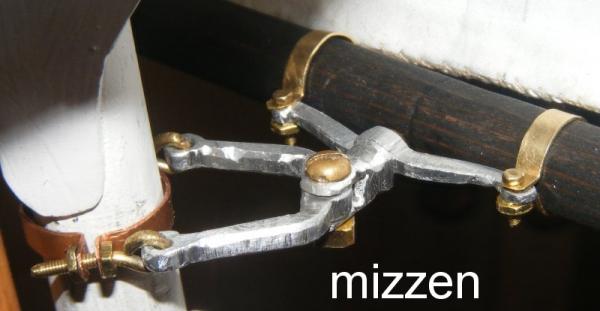
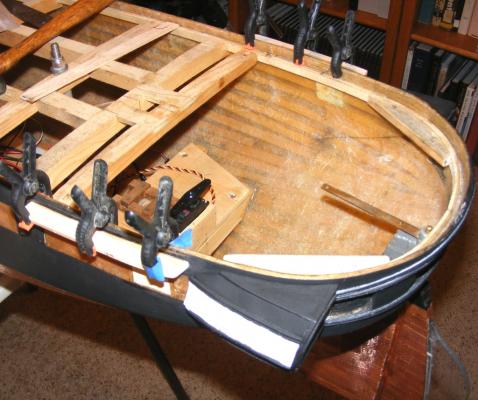
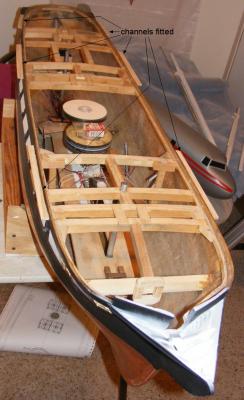
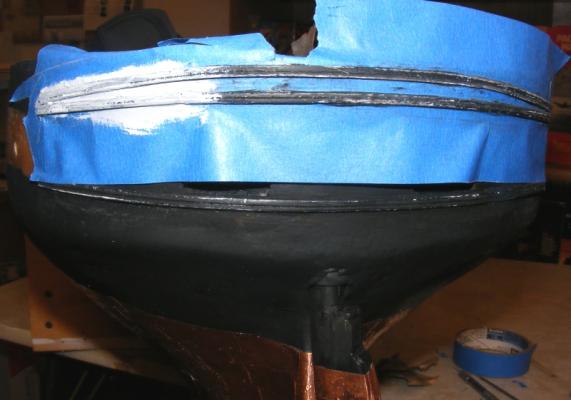
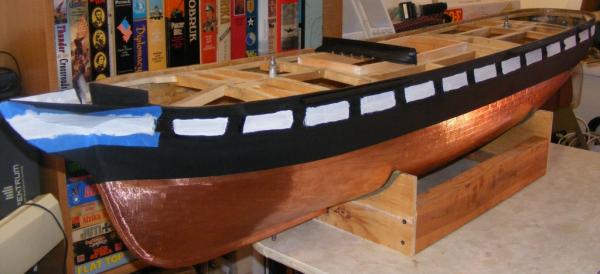
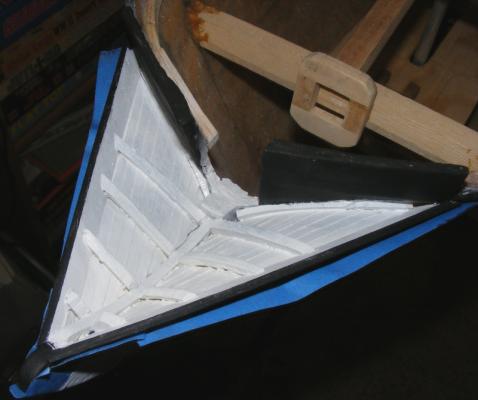
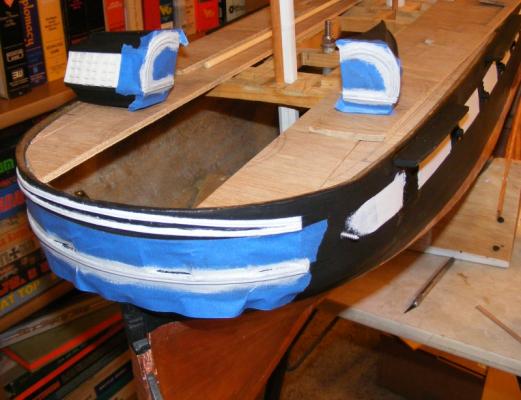
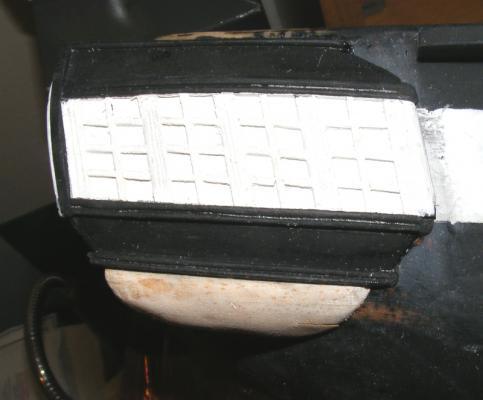
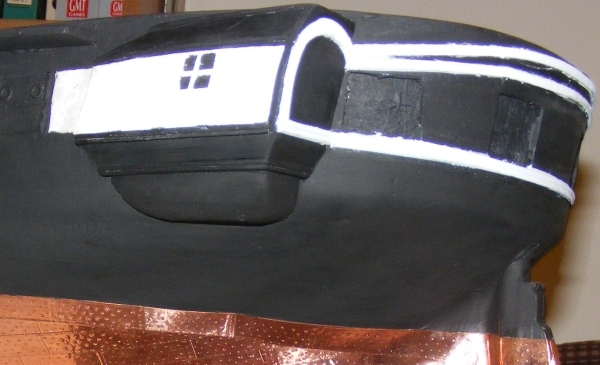
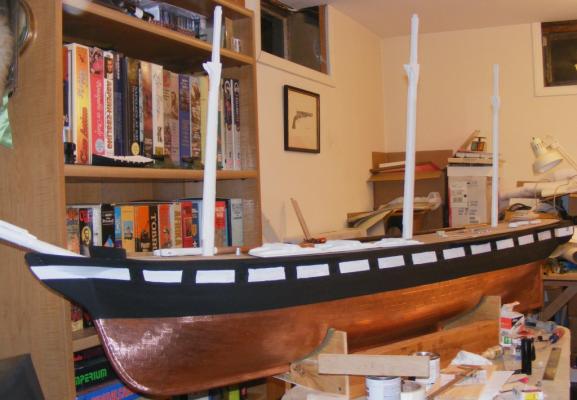
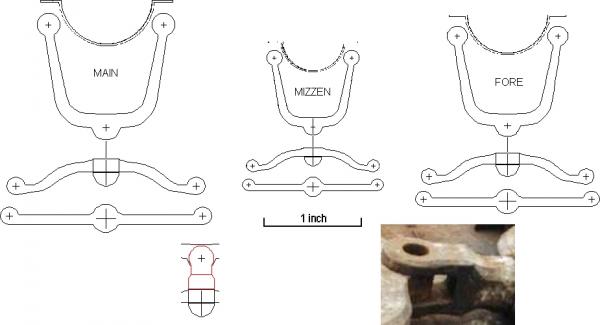
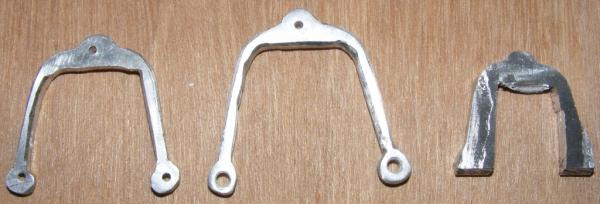
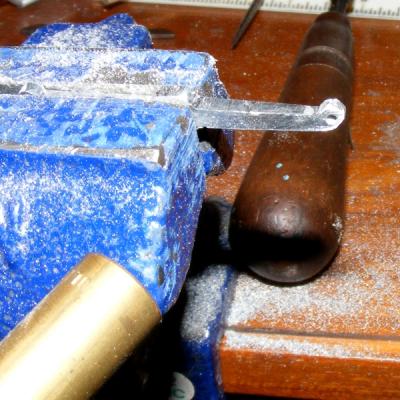
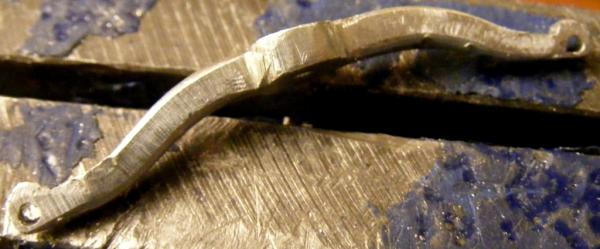
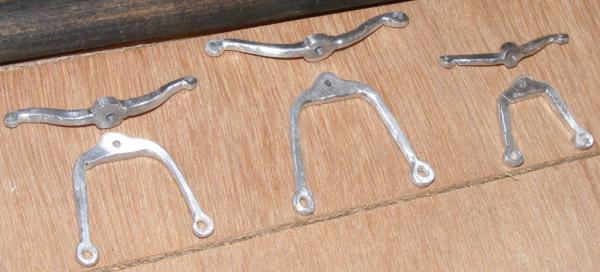
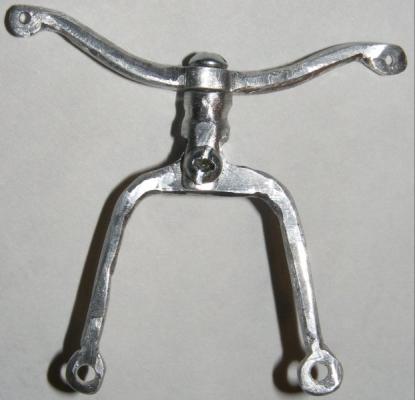
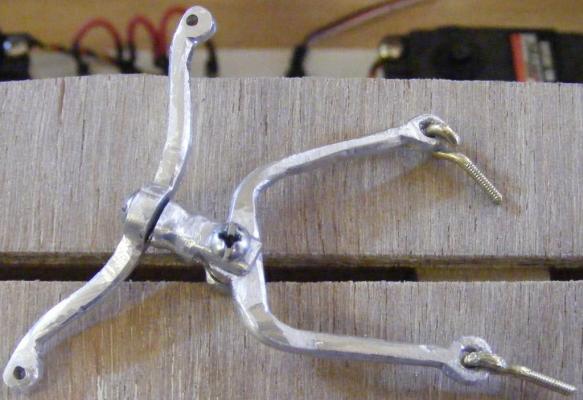
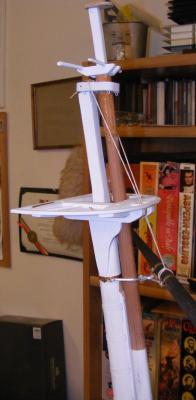
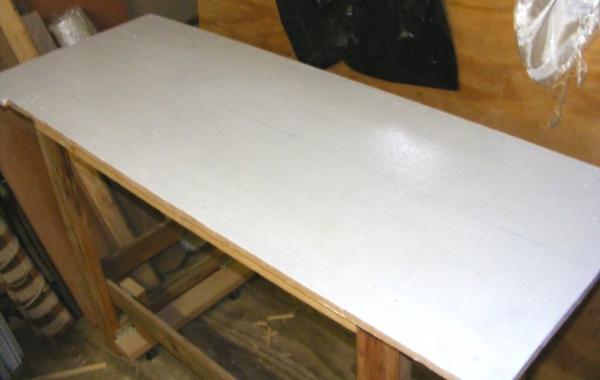
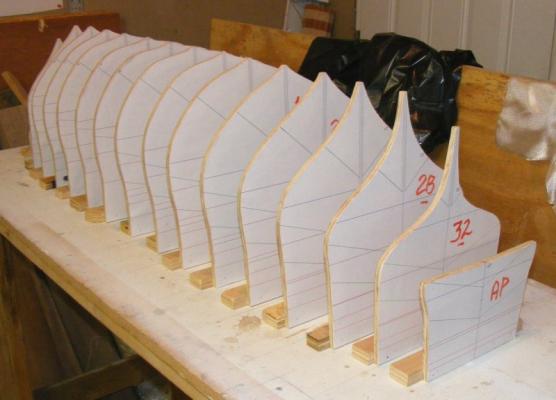
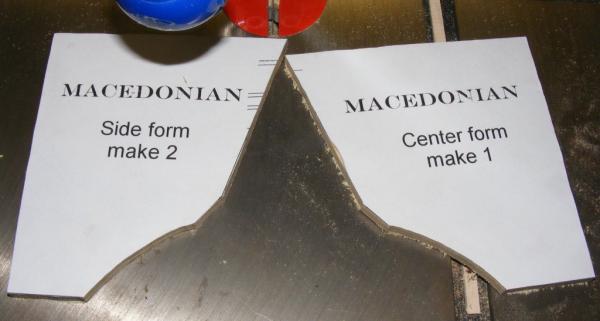
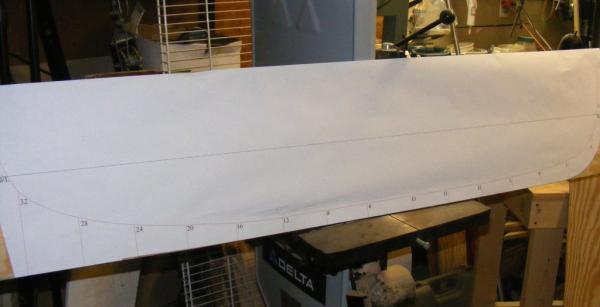
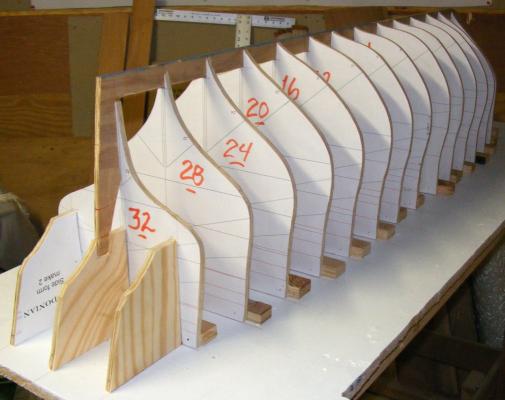
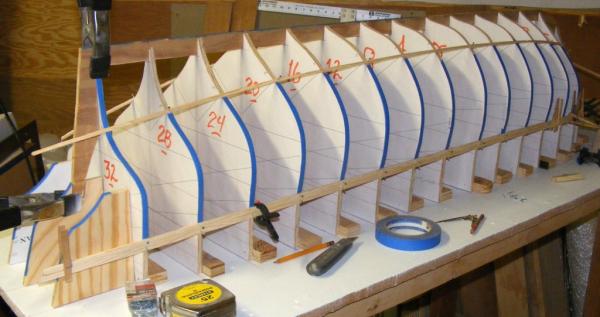
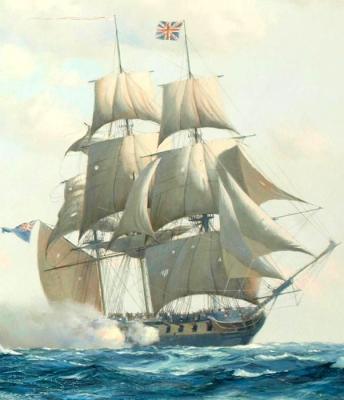
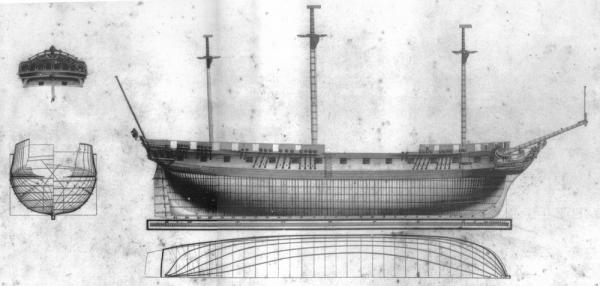
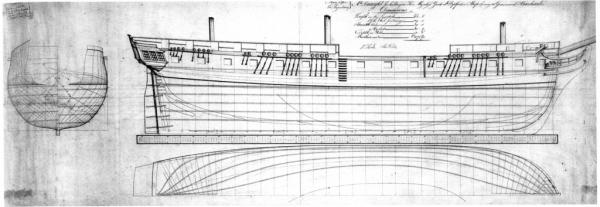
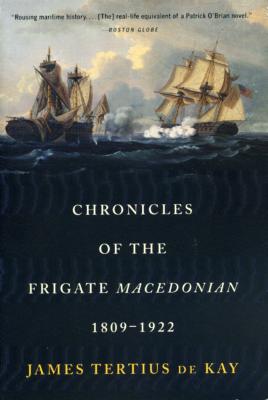
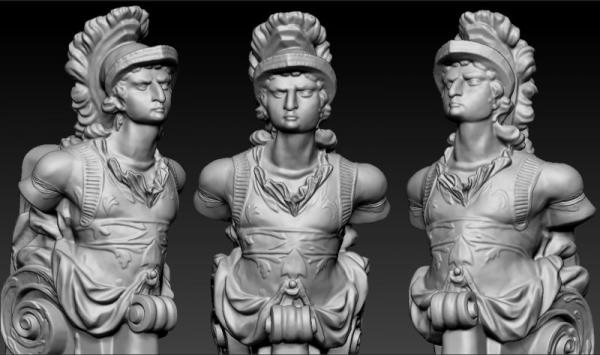
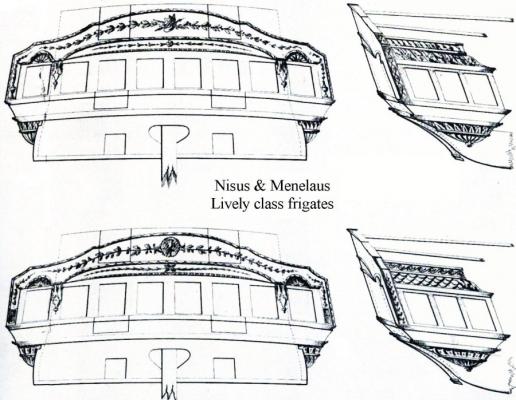
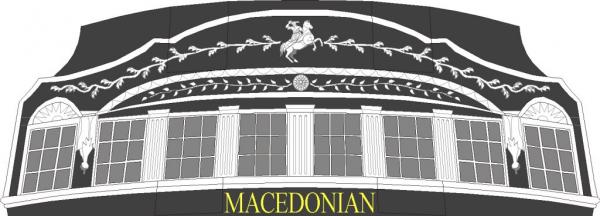
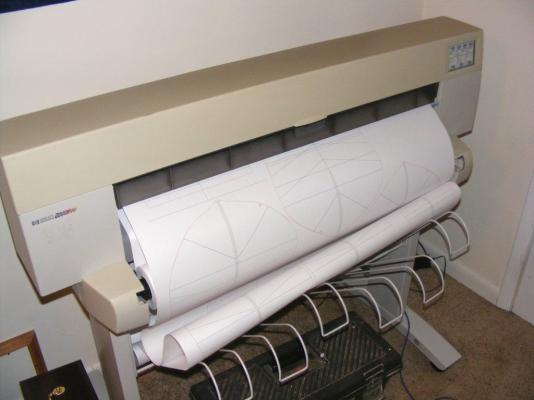
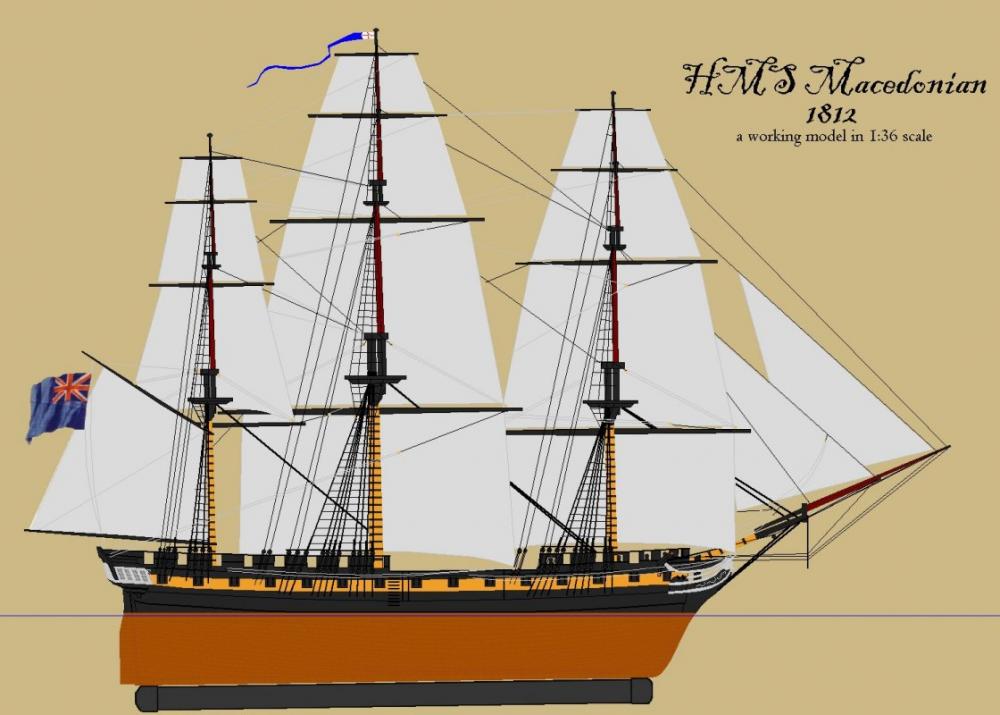
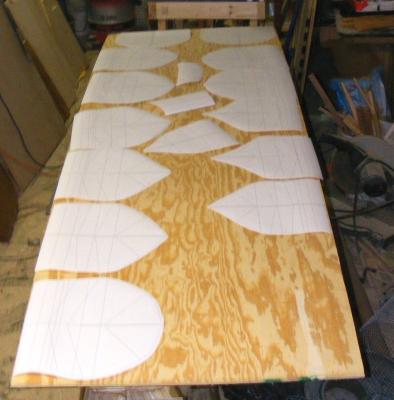
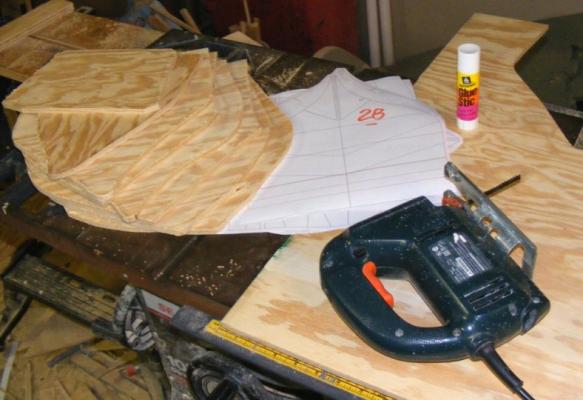
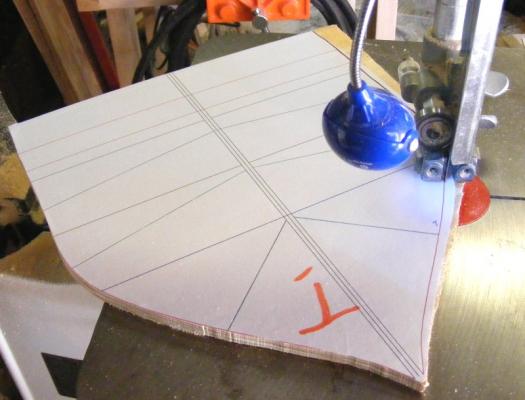
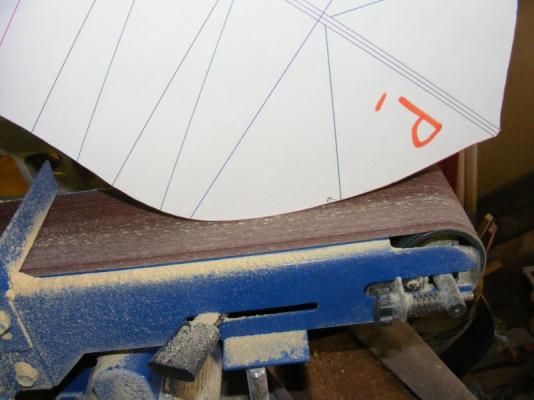

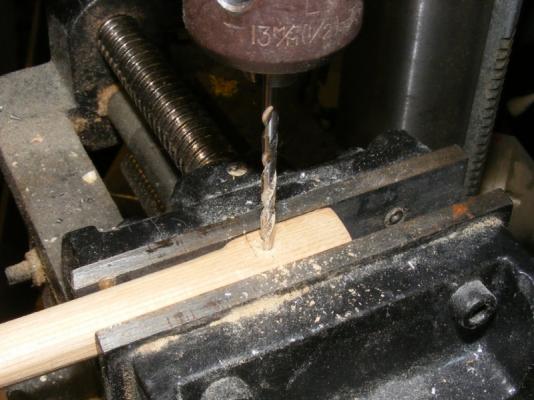
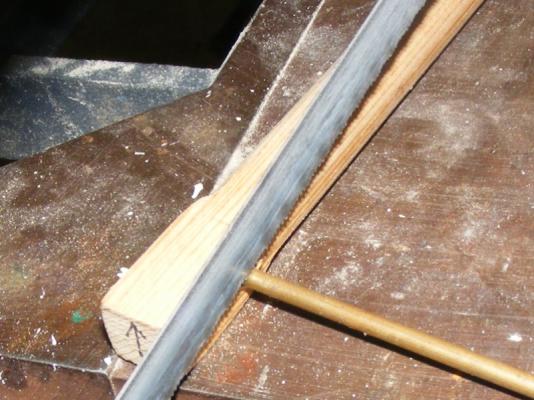
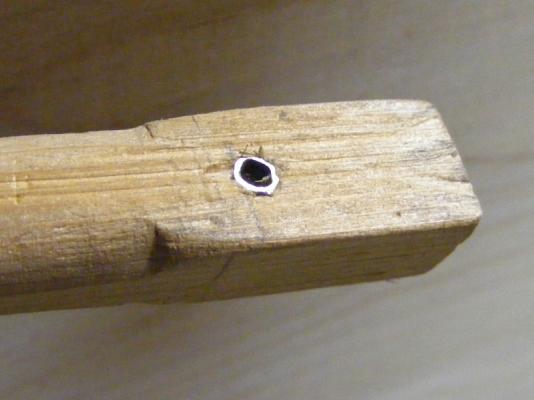
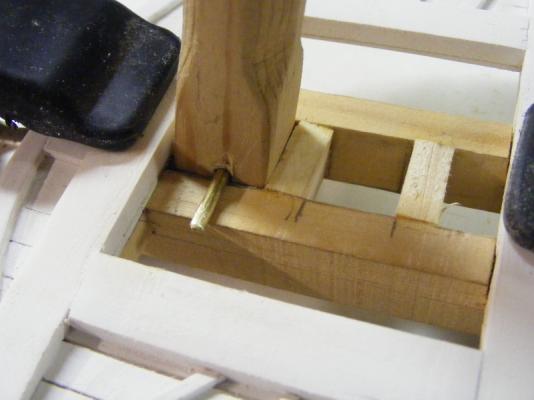
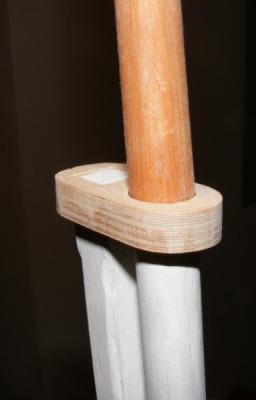
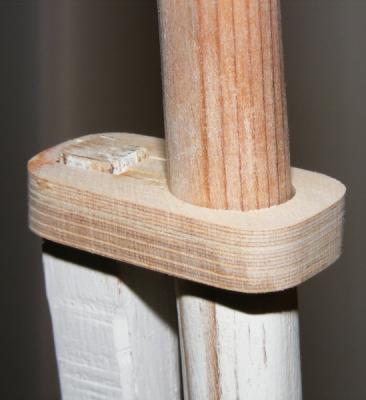
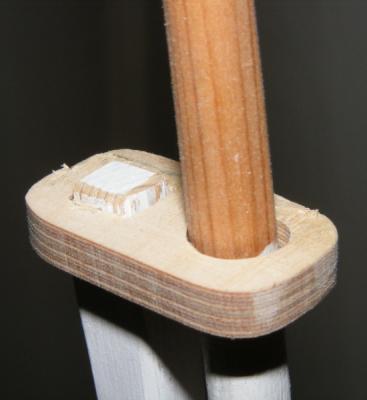
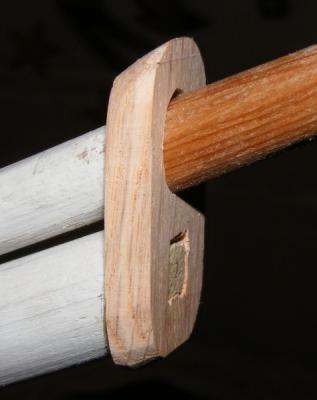
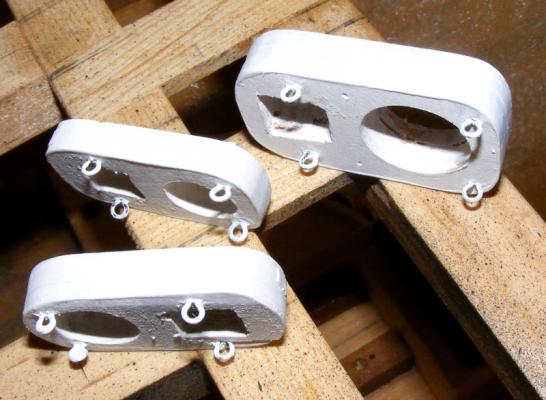
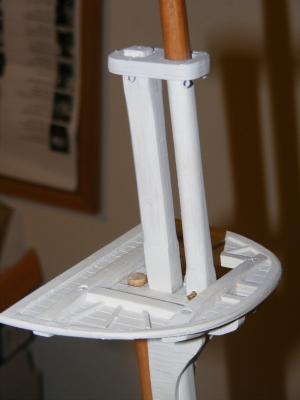
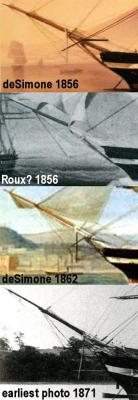
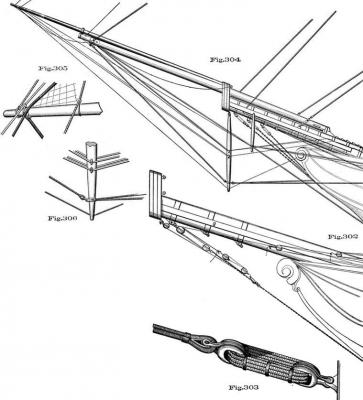
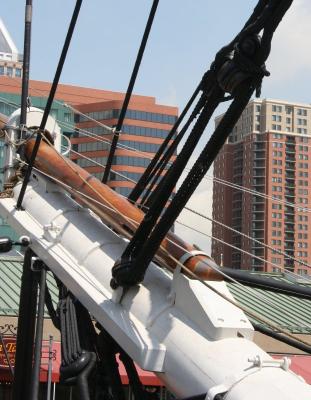
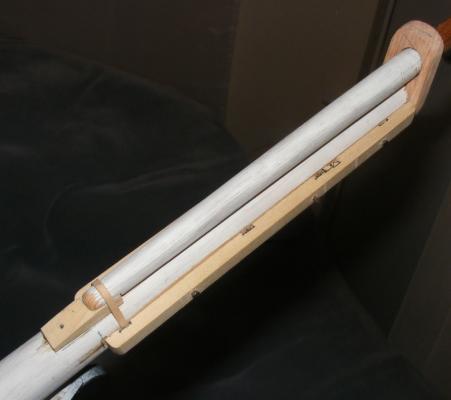
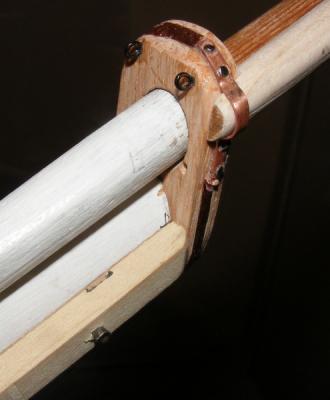
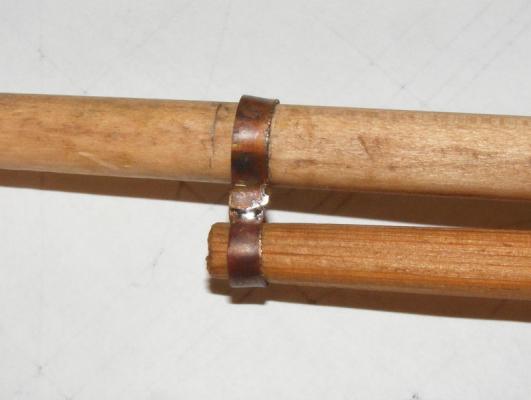
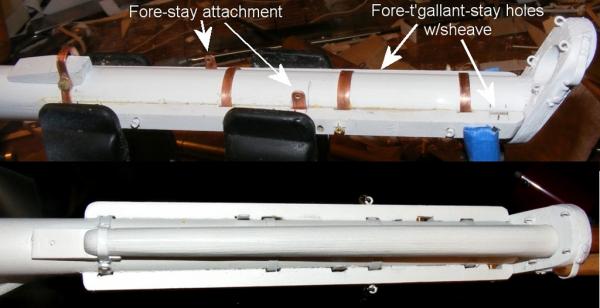
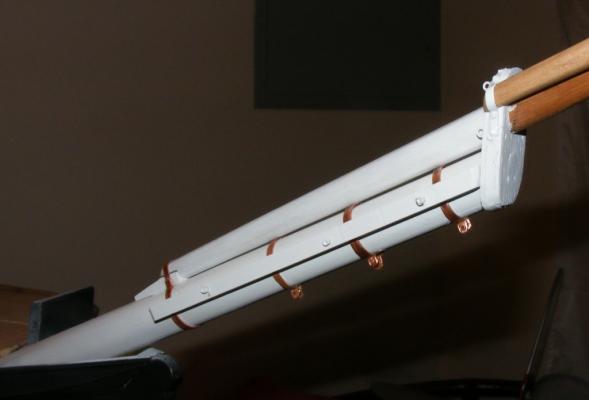
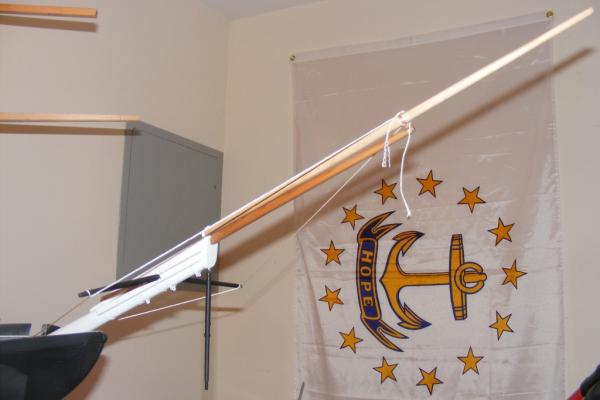
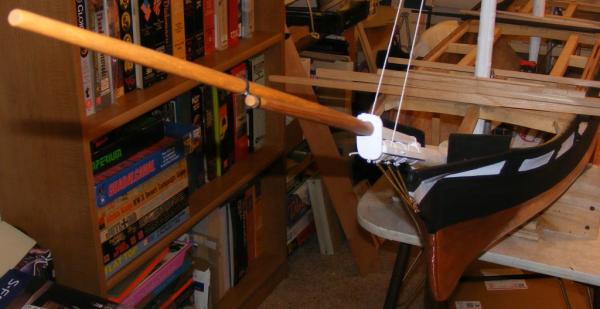
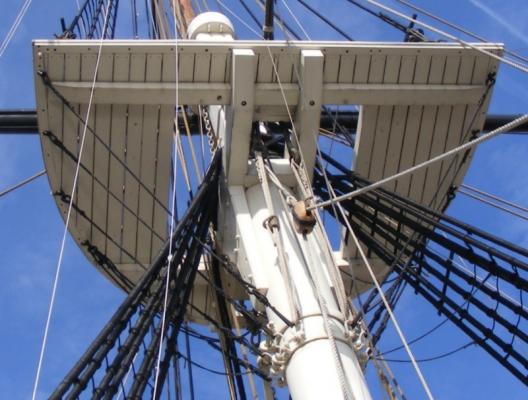
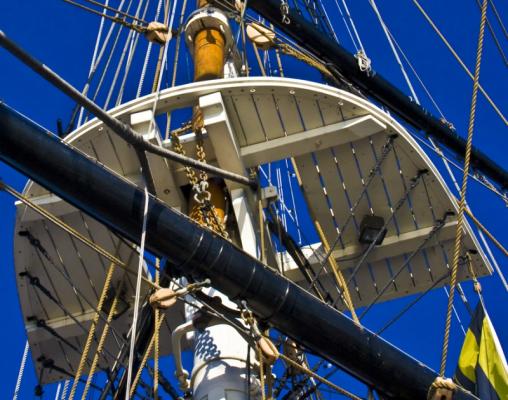
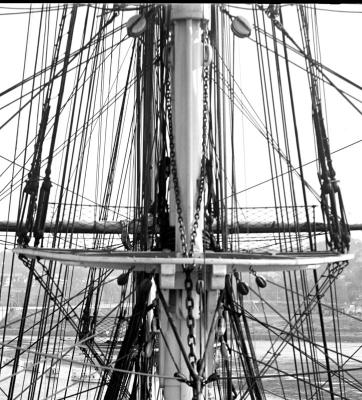
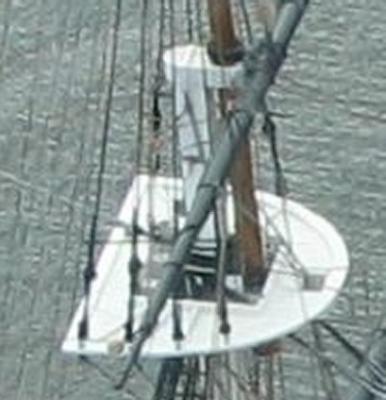
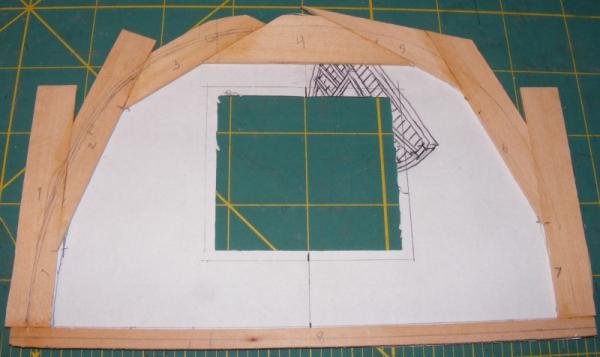
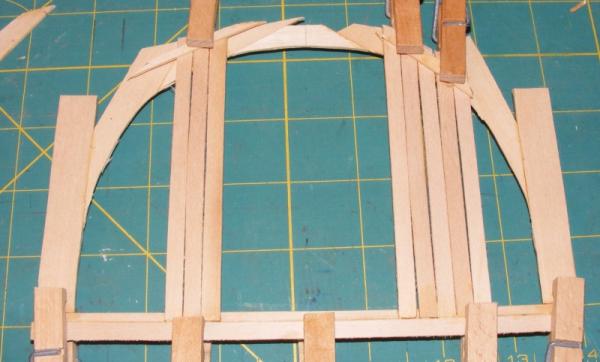
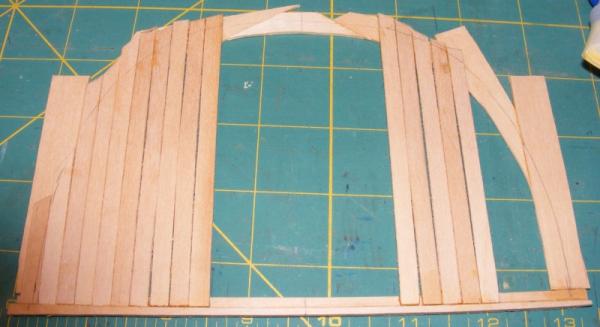
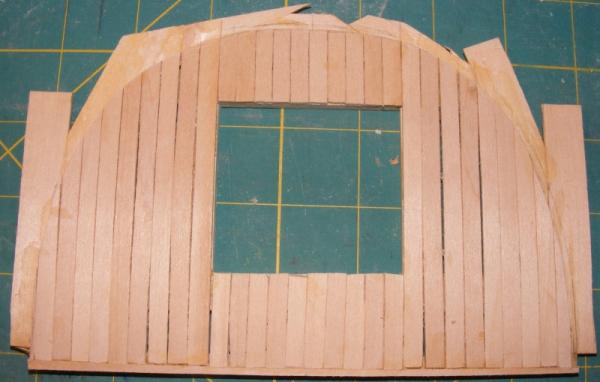
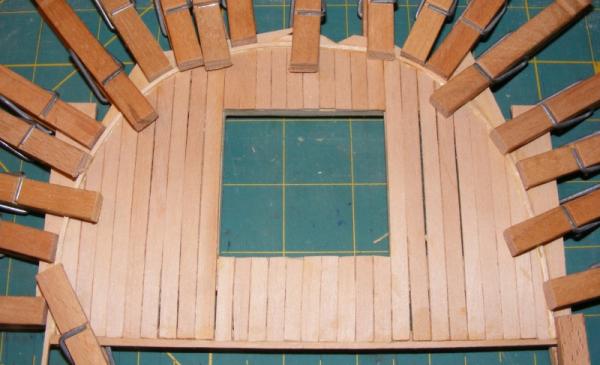
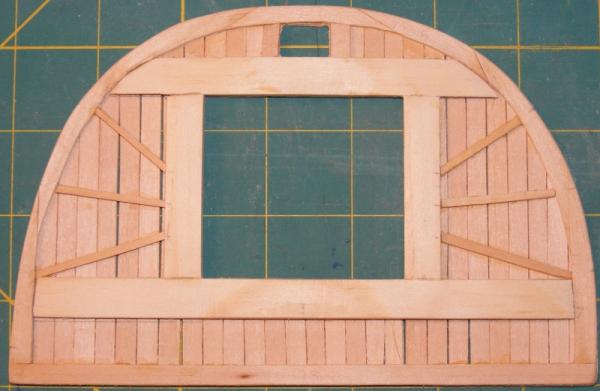
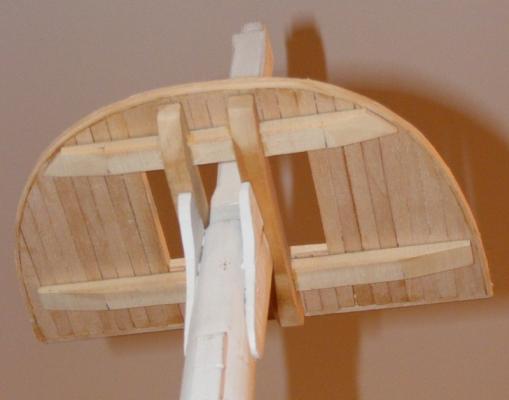
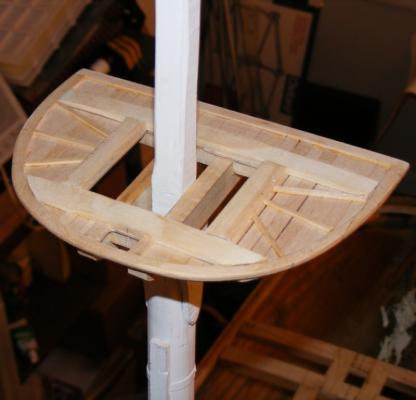
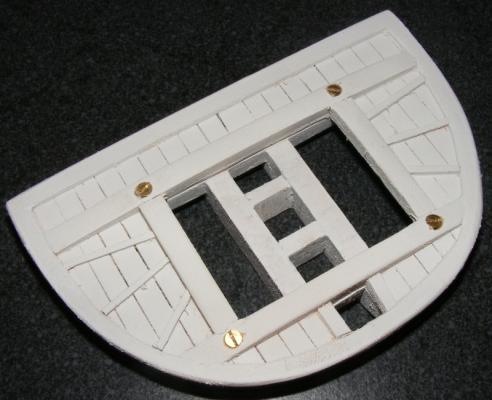
Pride of Baltimore by JerryTodd - 1:20 scale - RADIO - as she appeared in Fall 1981
in - Build logs for subjects built 1901 - Present Day
Posted
I don't think I have more than $200 invested in her yet. Her keel was some scrap 3/8" CDX plywood, as were her forms. Her planking was from some left over white pine 1-by-something "shelving board" my step-dad called it. The sails were a couple of yards of Supplex for $10-15. The radio was bought on ebay for about $100 and I have multiple receivers so I can run any one of the three models with the one transmitter. The servos were the expensive part at about $100 for the set of them. There's some glue, polyester resin and glass cloth - but no great quantities, and the single gallon of resin has served three models so far. Paint, but again, not any great quantities.
I'm a Scottish Jew, pinching pennies is in my blood.